

16 Best Trimarans For Sailing Around The World (And a Few For Daysailing)
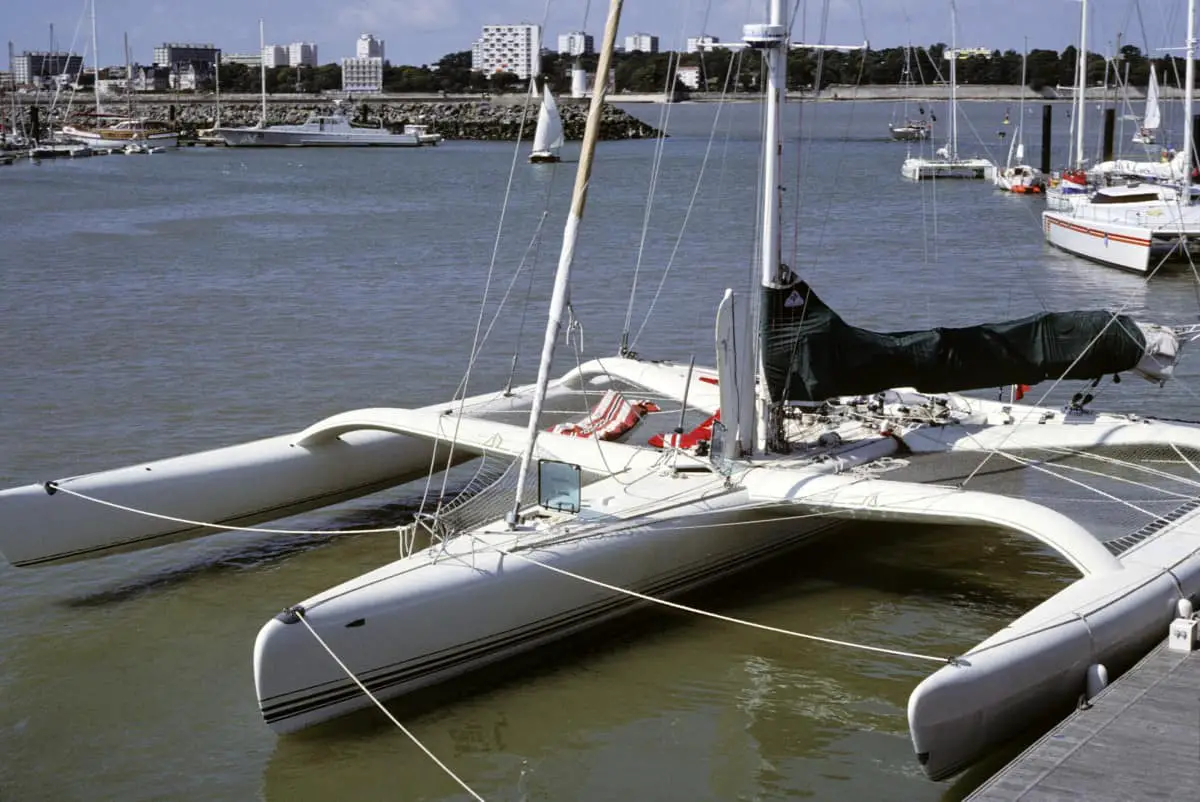
As an Amazon Associate, we earn from qualifying purchases. We may also earn commissions if you purchase products from other retailers after clicking on a link from our site.
Trimarans are growing in popularity worldwide, due to their light construction and high stability these multihulls are even faster than catamarans. Trimarans are still one of the lesser-known boat types so in this article ill be checking out some of the most popular models.
The best trimarans include:
- The Neel 43
- The Neel 47
- Dragonfly 28
- The Pulse 600
- Corsair 37
These tris are built with your safety in mind while also packing powerful speed and a wide array of comfort features to optimize your sailing experience , some are even foldable making them possible to load on a trailer and transport to the sailing destination of your choosing.
In this article, I have created a list of the 16 best trimarans in the market and their unique features. You’ll also learn the best options for different purposes such as circumnavigation, weekend sailing, racing, and more.
Table of Contents
What Is a Trimaran?

A trimaran is a multi hulled sailboat with three individual hulls; the main hull ( vaka ) and a pair of outrigger hulls ( amas ). These smaller outrigger hulls are attached to the main hull using beams.
While trimarans have a rich history dating back nearly four millennia, these types of sailboats have only gained popularity in the late 1900s and early 2000s.
Trimarans are primarily used as personal boats for sailing enthusiasts or racing. These sailboats draw their versatility from their lightweight design, making them faster and easier to handle at sea when compared to single-hulled boats (monohulls). Additionally, the three hulls also contribute to better stability, making it very hard to capsize (although more likely than a cat according to this study)
Trimarans come in various sizes, and some can be as small as 19 feet (5.8 meters) in length, while others go up to 60 feet (18meters). They’re also used for different purposes. Most trimarans are used for racing and recreational purposes, although some units are still used as ferries.
As with all things, to find out which is the best we need to understand what it will be used for. There is a big difference in requirements between a boat used for day sailing compared to offshore around the world sailing.
The list below highlights the best trimarans for different purposes.
Best Trimarans For Cruising, Liveaboard and Sailing Around The World
The Neel 43 is a French trimaran best suited for cruising. Its key features include:
- Easy maneuverability on the open sea by only a small number of crew members
This unit is also built for comfort, ideal for more extended travels. This 43-feet (13-meter) trimaran is also made with recyclable and bio-sourced materials, highlighting the manufacturer’s commitment to environmental consciousness.
This trimaran has a base price of €329,000 excluding VAT. This translates to approximately $370,138.
2.Neel 47 Possibly The Best
Named the best full-size multihull for 2020, the Neel 47 is a strong contender for one of the best trimarans in the market. This 47-foot (14.3-meter) long trimaran features optimized exterior and interior ergonomics for a unique design and look.
Still on design, the Neel 47 is ideal for couples looking to take a weekend off or spend some time as liveaboard. It has a spacious owner’s cabin and two bedrooms. It also features a spacious living room and kitchen and is optimized to ensure comfort for a couple.
The Neel 47 also has two basic guest cabins so your friends or children can tag along on your sailing adventure. Accordingly, this unit is ideal for those looking to explore the sea for the sheer joy of sailing.
The Neel 47 comes at a 571,139 euro ( $643,600 ) price tag, excluding VAT.
3. Rapido 60 The Fast and Comfortable Circumnavigator
The Rapido 60 offers a blend of performance, safety, and luxury, making it one of the best options for bluewater sailing. Measuring 59.3 feet (18 meters) in length, the Rapido 60 is an imposing unit. It’s made from lightweight sandwiches and carbon materials that provide speed and strength, allowing it to stand up to strong ocean currents.
The Rapido 60 also has spacious living spaces and is built for comfort at all points of the sail. Its design also optimizes safety. While it’s an ideal option for circumnavigating, it’s also an excellent choice for racing due to its speed.
This is also the same boat that The Youtube channel La Vagabond just purchased.
The Rapido 60 retails at $1,400,000 .
4. Rapido 40
The Rapido 40 measures 39.4 feet (12 meters) in length and is ideal for cruising around the world. The Rapido 40 features twin “C” foils, which provide added lift, enhancing its speed and performance whether you are sailing downwind or upwind.
Because it has C foils, this trimaran doesn’t have a central daggerboard, increasing interior space. Accordingly, it’s an excellent option for couples looking to cruise and enjoy great performances .
The Rapido 40 is made from high-tech all-carbon materials for a lightweight yet sturdy design. This material is also used for the countertops and furniture, and the cork flooring adds a touch of style.
This trimaran retails for $595,000 , making it a cheaper option than the Rapido 60.
5. Dragonfly 40
The Dragonfly 40 measures 40 feet (12 meters) in length. It features high-comfort standards, making it one of the best trimarans in the market for taking your family for a cruise. Because of its larger size, it has a better capacity, being capable of accommodating six to eight people, so you can bring your family and friends along.
It’s easy to navigate and extremely safe. With a maximum speed of 24 knots (44.5 km/h), this trimaran also provides fast speeds to make your cruise even more exhilarating.
The Dragonfly 40 retails from €509,000 exclusive of VAT, which rounds up to $572,000 .
6. Dragonfly 32
The Dragonfly 32 is a high-performance cruiser. Like the Dragonfly 28, this unit features a contemporary design for racing. This trimaran can accommodate five to seven crew members.
Although slightly longer than the Dragonfly 28 with its 32-foot (9.8-meter) length, the Dragonfly 32 has a max speed of 23+ knots (42.6+ km/h), making it one of the fastest trimarans for racing. This unit also has comfortable accommodation, which makes it an ideal option for a weekend cruise with family and friends.
The Dragonfly 32 has a base price of $350,000 .
7. Corsair 37
Thanks to a variable draft with a retractable rudder, the Corsair 37 is an ideal choice for shallow water exploration. This 37-foot (11.3-meter) long trimaran features advanced foam-cored construction designed for safety, making it virtually unsinkable.
The carbon hulls minimize weight, this makes for a lightweight ocean exploration sailboat with blistering speeds. One of its selling points is that this trimaran has previously been used for Arctic expeditions, possibly marking it as one of the better options for circumnavigation and offshore sailing in the northern waters.
This trimaran has a base price of $189,000 but can go up to $204,125 .
Best Trimarans For Day/Weekend Sailing
8. dragonfly 28.
The Dragonfly 28 is a 28-feet (8.75-meter) long sailboat that can accommodate up to five people. It comes in two versions:
- Touring version: This version is ideal for families.
- Performance version: This is built to provide optimal performance for the sports enthusiast within you.
It clocks a maximum speed of 22+ knots (22+ km/h) and is beam-folded. It’s an excellent option if you want a high-performance, comfortable yet smaller unit for your day or weekend cruise.
The Dragonfly 28 starts at €188,280 inclusive of VAT, which comes to around $211,600.
9. Dragonfly 25
Like other trimarans under the Dragonfly brand, this 25-foot (7.62-meter) trimaran is great for both racing and short term cruising. However, this high-performance boat delivers easy handling, making it perfect for couples looking to take a ride out over the weekend and seasoned sailors looking for an exhilarating racing adventure.
The Touring version features a lightweight build and offers comfort and accommodation to keep you, and the few guests you can fit, comfortable during the ride. This trimaran also has a Sport version, which is optimized for racing.
The Dragonfly 25 retails from EUR 86,800 .
10. Pulse 600
The Pulse 600 trimaran is a compact sailboat. It’s made from lightweight, carbon-reinforced construction and vacuum-formed materials for optimal speed. This trimaran is an ideal option if you are looking for speed.
It also features ample deck space, greater stability, and volume than most trimarans of similar size and build.
This trimaran measures 19.8 feet (6 meters) in length and can be sailed single-handedly by one person with minimal effort. The Pulse 600 has a base price of $38,800 , which places it in the lower price range.
The F-22 is one of the smaller trimarans in the market. Developed in New Zealand, the F-22 is a folding trimaran built for speed. The hulls are made from narrow fiberglass tied together using fiberglass beams and aluminum, minimizing bulk while optimizing speed.
The F-22 is roomy and is not as pricey as other models in the market. This trimaran has two main versions:
12. 2019 Weta Trimaran
The 2019 Weta trimaran is a 14.5-foot (4.4-meter) trimaran featuring a carbon frame, centerboard, rudder foil, and rudder shock. The hull is made from fiberglass and foam. The Weta is built for strength and speed based on these lightweight materials.
The 2019 Weta trimaran is easy to sail and is worth considering whether you want to take a quiet sail, race with your friends, or take kids to a sailing lesson. It has a simple design and is easy to set up independently. Thanks to its collapsible design, this trimaran is easily stored away with minimal space demands.
13. WindRider 17
The 17.4-foot (5.3-meter) WindRider 17 is one of the more versatile trimarans in the market. It packs high performance for a low cost. This trimaran has a light rotating mast to boost performance, and a full-battened mainsail optimizes visibility.
This sailboat is made from rotomolded polyethylene, which is more durable than fiberglass and demands less maintenance.
The WindRider 17 has a comfortable interior and can fit six adults. This is an ideal choice for social sailing for a couple or a family and friends. It’s easy to ride, and a shallow draft allows easy maneuverability.
14. Astus 22.5
If you’re looking for something small but still comfortable, this 22.5-foot trimaran is for you. Built for speed and maneuverability, the Astus 22.5 has optional foils to optimize speed. The modern design, coupled with the spacious interior, can fit up to four beds. Accordingly, this trimaran is suited for family outings.
This trimaran also has a foldable design, collapsing to only 16 feet (4.9 meters) for easy storage.
15. Multi 23 Trimaran
The Multi 23 trimaran has a contemporary design, featuring a vinyl ester and PVC foam core construction. The section below the waterline is made of solid glass for a sturdy base.
The beams are made of lightweight carbon, and the trimaran features a 33-foot (10-meter) aluminum rotating wing mast for optimal harnessing of the wind. While ideal for weekend excursions with family, once rigged with the asymmetrical spinnaker will get your heart pumping.
This trimaran packs high performance at a lower cost than most other options in the market. It’s a good choice if you are looking for a high-performing unit without spending an arm and a leg.
16. Challenger Class Trimaran
The Challenger Trimaran 15 is the best choice for persons with disabilities. It’s designed to provide disabled sailors an opportunity to explore their passion for sailing without worrying about aspects like safety or operation.
A man named Geoff Hold circumnavigated the British Isles in 2007, becoming the first disabled person to achieve this feat. He had quadriplegia.
Living up to its name, the Challenger can withstand harsh weather conditions while blending performance with speed.
Final Thoughts
Admittedly, no trimaran is best for everyone. But whether you are looking to race with your friends, take your loved ones or friends for a cruise over the weekend, or circumnavigate the ocean, you can rest assured that these lightweight trimarans will deliver speed, safety, and comfort to make it worth your while.
These brands are innovatively designed and feature intricate safety mechanisms that make them virtually unsinkable. Give them a shot and begin your ocean adventure.
- Basco Boating: A Comprehensive Guide & Introduction to Trimaran Yachts
- TheBoatAPP: New Trumarans: Which are the Best Ones
- Corsair Marine: Corsair 37
- Dragonfly: Dragonfly 28
- Rapido Trimarans: Rapido 60
- Neel Trimarans: Neel 43
- Yachting World: World’s Collect Yachts: Maxi Trimaran MACIF
- Yachting Monthly: Dragonfly 28 Performance
- Rapido Trimarans: Rapido 40
- Dragonfly: Dragon 32
- Dragonfly: Dragonfly 40
- Yachting World: Dragonfly 40 yacht tour: This cruising trimaran can do 24 knots
- Dragonfly: Dragonfly 25
- NauticExpo: Dragonfly 25
- Yachtworld: Corsair 37 boats for sale
- Cruising World: Neel 47 Trimaran: Best Full-Size Multihull0
- Neel Trimaran: Neel 47
- Multihull Solutions: NEEL 47 Boat Review | Cruising World
- Yacht World: 2022 Neel 47 for sale
- Farrier International: F-22
- Weta Marine: The Boat
- WindRider: WindRider 17 Trimaran Sailboat
- Astus Boats: Astus 22.5
- Boat-specs: Multi 23
- National Maritime Museum Cornwall: Challenger Trimaran #1 – BC26
Owner of CatamaranFreedom.com. A minimalist that has lived in a caravan in Sweden, 35ft Monohull in the Bahamas, and right now in his self-built Van. He just started the next adventure, to circumnavigate the world on a Catamaran!
Leave a Reply Cancel reply
Your email address will not be published. Required fields are marked *
Save my name and email in this browser for the next time I comment.
Recent Posts
Must-Have Boat Gear for Catamaran Sailors!
Sailing is probably the most gear-intensive activity I've ever done; there are so many decisions to be made about what gear to buy now, for tomorrow, and what to definitely never buy. The gear on...
6 Best Trailerable Trimarans For Bluewater and Coastal Sailing
Having a boat costs a lot of money, even when you are not using it, marina fees, etc. And once it is in the water most sailors never go very far from their "home marina" and sailing will be somewhat...
Free Shipping in the US on Orders $75+

Item added to your cart
The complete list of trimarans.
There is no single trimaran that is best for everyone. Where some prefer luxury cruisers for long trips with family and friends, others might opt for a high performance racing tri for thrilling rides at breakneck speeds. With the recent spike in trimaran popularity, these days there is a perfect tri for every sailor. So to help prospective trimaran owners decide which boat is just right for them, we here at WindRider have put together a comprehensive list of the best trimarans on the market today! Read through for simple at-a-glance trimaran comparisons of boats both big and small, exhilarating and relaxing, and for all price points.
Jump to a specific sailing trimaran: Neel Weta Corsair WindRider Dragonfly Catri Astus Hobie Sea Pearl Farrier Sea Cart Multi 23 Triak SeaRail Warren Lightcraft Diam Radikal Challenger

Known for their award-winning luxury trimarans, NEEL is based in La Rochelle, the capital city of sailing in France. NEEL trimarans are built for fast cruising with an average cruising speed of about 10 knots, and are even configured to facilitate that sustained speed under motor propulsion. The NEEL 45 was notably named Cruising World’s Most Innovative Vessel in 2013, and by all accounts is an easy-to-sail, high performance boat that is just plain fun.
At a glance:
Models: NEEL 45, 65
Length: 45’ – 65’
Cost: $$$$$
Use: Luxury cruiser

A fan favorite, Weta trimarans are fast, stable, and remarkably easy to rig. This single-sailor tri has a capacity of up to three, and the ease with which it can be transported and stored makes this a great, versatile boat for beginners. The Weta was named Sailing World’s 2010 Boat of the Year, and one ride is enough to know why: simply put, the Weta is an absolute ton of fun to sail regardless of skill level.
Models: Weta
Length: 14’5”
Cost: $$ $$$

The high-end Corsair trimaran definitely holds its own in the categories of versatility, performance, and convenience. Boasting a rigging time of 30 minutes from trailer to sailor , the Corsair 42 – whose convenient folding amas makes trailering possible – is a simple option even for single sailors, though cabin space is suitable for two adults. These boats are wicked fast, capable of reaching speeds of 20+ knots, and were made for skilled sailors seeking solid construction and high performance vessels, not for beginners.
Models: Pulse 600, Sprint 750 MKII, Dash 750 MKII, Corsair 28, Cruze 970, Corsair 37, Corsair 42
Length: 19’8” – 37’
Cost: $$$$ $
Use: Sports cruisers

Built for the sailor who wants to maximize the joys of sailing while minimizing any hassle, WindRider trimarans are notoriously fast, very safe, and a blast to sail from start to finish. With several models that can hold between 1 and 6 riders, including adaptive designs to allow participation from sailors of all levels of mobility, there’s something to suit every sailor’s needs. The WindRider 17, an exhilarating ride perfect for families or camper sailors, has been known to reach speeds of up to 20mph. This easy day sailor goes from trailer to sailing in under 30 minutes and is sure to fit in perfectly with whatever adventures you have planned.
Models: WR 16, 17, Tango, Rave V
Length: 10’11” – 18’3”
Cost: $ $$$$
Use: Day sailor

The Danish-built Dragonfly trimarans come in a variety of models ranging from 25’ – 35’, all known for their spry performance, comfortable ride, and ease of use. Every model comes equipped with the unique “SwingWing” feature, a motorized system that can unfold the amas even while the boat is already underway – making it accessible to marinas and slips, and even makes trailering possible. Perfect for those who don’t want to sacrifice their comfort for high performance, the Dragonfly can breeze along at 13 knots while remaining one of the quietest compact cruisers out there.
Models: Dragonfly 25, 28, 32, 35, 1200
Length: 25’ – 39’

Designed for both safe cruising as well as for high speed racing, Catri trimarans will make your day. Especially noteworthy is the Catri 25, a stable yet wildly fast foiling trimaran with accommodations for up to 6 people. With profiles optimized for speeds of 25+ knots when foiling, this is no beginner’s sailboat. The special attention paid to stability in the foil design allows the Catri to be a single sailor vessel, even at foiling speed, with no special physical abilities. Whether you’re taking a small crew for longer rides at shuddering speeds or bringing the whole family along for a shorter, but still thrilling sail, the Catri is truly one of a kind.
Models: Catri 25
Length: 25’
Use: Cruiser/racer

A popular brand of trimaran in Europe, Astus has recently made its way to the US market to the delight of sailors on this side of the pond. Designed to offer maximum pleasure with minimum hassle, all models of Astus trimarans are fast to set up, quick on the water, inherently stable, and always a joy to sail. Their outriggers are mounted on telescopic tubes for easy stowage and towing, and can even be extended and retracted on the water for access to narrow passageways and monohull slips in marinas. With models in all sizes and price points, Astus trimarans are a great option for any sailor.
Models: Astus 16.5, 18.2, 20.2, 22, 24
Cabin: Some models
Length: 16’ – 24’
Use: Sport cruisers
HOBIE ADVENTURE ISLAND

Great for beginners and adventurers alike, the Hobie Mirage Adventure Island series is nothing if not just plain fun. With the option to use as a kayak or as a very basic trimaran, the Hobie is transportable, versatile, unintimidating, lightweight, and wonderfully affordable. The pedal system known as “Mirage Drive” allows a person to pedal the kayak using their legs for an extra kick of movement in slow winds. Amas tuck close to the main hull for docking or car-topping, adding serious ease and convenience to the exhilarating experience of the Hobie.
Models: Hobie Mirage Adventure Island, Mirage Tandem Island
Length: 16’7” – 18’6”
Use: Convertible kayak/trimarans

Best known for its use in camp cruising excursions, the Sea Pearl offers a roomy main hull and particular ability to sail in very shallow waters, making beaching and launching a breeze. The lightweight Sea Pearl trimaran is easy to tow, and the larger-than-expected cabin opens this vessel up for overnight adventures with plenty of storage space. The simple design makes the Sea Pearl notoriously low maintenance, and the ease it takes to rig and sail it add to the overall delight of owning this boat.
Models: Sea Pearl
Length: 21’
Use: Camper cruiser

Quick, lightweight, roomy, and trailerable, Farrier trimarans are made for versatility to fit every sailor’s needs. Different Farrier models are available in plan or kit boat form for those who appreciate building their boat themselves, but of course, also as the full production sail-away boat for the rest of us. Single-handed rigging and launching takes under 10 minutes from start to finish, minimizing hassle and getting you on the water fast. All non-racing Farrier designs use a minimum wind capsize speed of 30 knots or more to ensure safety for all those aboard. Add the roomy cabin and high speed capabilities to the equation and you’ve got a boat that is great fun for everyone.
Models: F-22, 24, 25, 82, 27, 28, 31, 9A, 9AX, 9R, 32, 33, 33R, 33ST, 36, 39, 41, 44R
Length: 23’ – 39’4”
Cost: $$$ $$
Use: Sport cruisers/racers

One of the biggest names in the game, SeaCart is internationally noted for its high performance trimarans that far exceed expectations for a production boat of its size. The SeaCart trimaran performs as brilliantly off the water as it does on with its super-light and efficient harbor folding system, making light work of trailering. Notoriously easy to manage and maintain, the SeaCart 26 One Design is the ultimate day racing trimaran, designed for both course and inshore/coastal distance racing. Absolutely worth the international buzz it has garnered, the SeaCart is a thrill from beginning to end.
Models: SeaCart 26
Length: 26’

A high performance racer class, the Multi 23 is a lightweight, powerful trimaran known for its wicked speed of up to 25 knots. Multi trimarans of both available configurations were designed to give beach cat thrills and speed without any of the stability or seaworthy concerns. Open ocean sailing is no issue for the Multi’s big bows, which do their job to keep her stable. Built for sailors with a need for speed, the Multi makes a perfect weekend boat for racers, especially those with a taste for boat camping.
Models: Multi 23
Length: 23’

Another dual outrigger sailing kayak/canoe design, the Triak trimaran was designed to be effortless and fun, especially for beginners. Paddle the kayak with sails furled, use the foot pedals for an extra kick of momentum, or sail with just the mainsail – the only boat in its class to feature an asymmetrical spinnaker – for exhilarating speeds and a blast on the water. Car-top the Triak anywhere for a quick sail or plan for a week long expedition, but always count on having a great time on this easy little boat.
Models: Triak
Length: 18’
Use: Convertible kayak/trimaran

SeaRail trimarans are known for being affordable, light weight, trailerable trimarans that offer the perfect combination of exciting and relaxing experiences to a wide range of sailors. Whether it’s day sailing with your family, resort or camper sailing, SeaRail trimarans are ideal leisure vessels. Leave the hassle to the other boats – the SeaRail takes you from trailer to sailor in 15 minutes. But don’t let its reputation as a leisure tri fool you: if speed is what you want, rest assured that the SeaRail can deliver that as well.
Models: SeaRail 19
WARREN LIGHTCRAFT

Warren Lightcraft trimarans , another example of a convertible kayak-to-sailboat option, are known for their aesthetically pleasing designs that are also, as the name implies, very light for simple transportation and ease of use. Convert the kayak into a fast, high performance sailboat in just minutes, fly around on the waves all day long, then simply car-top the 68lb Warren for a maximum enjoyment, low-hassle day on the water. Perfect for sailors and paddlers of all skill levels, the Warren Lightcraft is the best of both worlds and an absolute joy to sail.
Models: Warren Lightcraft
Length: 15’6”

Built strictly with racing in mind, the Diam 24 is a light, powerful one-design class trimaran and a notoriously exceptional performer. Boasting blistering speeds of up to 30 knots, Diam trimarans are not intended for beginners. For racers who crave the very best in terms of intense speeds, smooth handling and impeccable performance, the Diam is the red-hot one-design racing tri for you.
Models: Diam 24
Length: 24’

For the sailor who prefers the finer things in life, the Radikal 26 delivers. Perfect for bringing the whole family out for a day on the water, this high performance, trailerable sailing trimaran strikes the most luxurious balance between quicksilver speeds and a smooth, comfortable ride. The Radikal 26 trimaran is as convenient to transport and set up as it is pleasant to sail, with a folding system that minimizes rigging hassle and also makes this a trailerable tri. Built for a fast and comfortable sail rather than a hold-onto-your-seats thrill, one-the-water safety and overall pleasure makes the Radikal 26 what it is.
Models: Radikal 26
Use: Sport cruiser

A solidly-built, single-handed trimaran, the Challenger also doubles as an adaptive design – meaning it is made to accommodate sailors of all levels of physical mobility. Best suited to lakes, the Challenger is a very safe, seaworthy boat for sailors of all ages and experience levels. Add to this the ease of owning, transporting and maintaining the Challenger trimaran and what you get is a simple, fun sailboat perfect both for beginners and those seeking a cheap thrill alike.
Models: Challenger
At a glance comparison:
| Astus 16.5, 18.2, 20.2, 22, 24 | 16’ – 24’ | Sport cruiser | Some models | ||
| Catri 25 | 25’ | Cruiser/racer | Y | ||
| Challenger | - | Day sailor | N | ||
| Pulse 600, Sprint 750 MKII, Dash 750 MKII, Cruze 970, Corsair 28, 37, 42 | 19’8” – 37’ | Sport cruisers | Y | ||
| Diam 24 | 24’ | Racer | N | ||
| Dragonfly 25, 28, 32, 35, 1200 | 25’ – 39’ | Luxury cruiser | Y | ||
| F-22, 24, 25, 82, 27, 28, 31, 9A, 9AX, 9R, 32, 33, 33R, 33ST, 36, 39, 41, 44R | 23’ – 39’ 4” | Sport cruisers/racers | Y | ||
| Mirage Island, Mirage Tandem Island | 16’7” – 18’6” | Convertible kayak/trimarans | N | ||
| Multi 23 | 22’ | Racer | Y | ||
| NEEL 45, 65 | 44’ – 65’ | Luxury cruiser | Y | ||
| Radikal 26 | 26’ | Sport cruiser | Y | ||
| Sea Pearl | 21’ | Camper cruiser | Y | ||
| SeaCart 26 | 26’ | Racer | Y | ||
| SeaRail 19 | 18’ | Day sailor | N | ||
| Triak | 18’ | Convertible kayak/trimaran | N | ||
| Warren Lightcraft | 15’6” | Convertible kayak/trimaran | N | ||
| Weta | 14’5” | Racer | N | ||
| WR 16, 17, Tango, Rave V | 10’11” – 18’3” | Day sailor | N |
Did we miss one? Let us know. Tell us what you sail and what you like about each boat in the comments below.
- Choosing a selection results in a full page refresh.
- Opens in a new window.
- AROUND THE SAILING WORLD
- BOAT OF THE YEAR
- Email Newsletters
- America’s Cup
- St. Petersburg
- Caribbean Championship
- Boating Safety
- Ultimate Boating Giveaway

2023 Boat of the Year Best Multihull: Neel 43
- By Dave Reed
- December 16, 2022
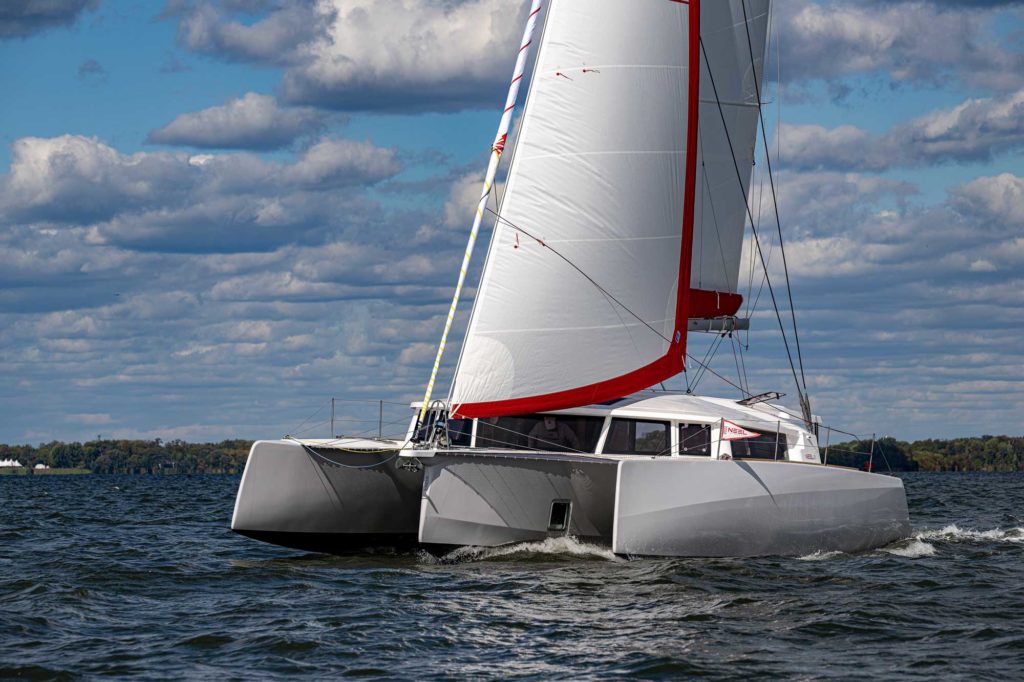
Sailing World Magazine’s annual Boat of the Year tests are conducted in Annapolis, Maryland, following the US Sailboat Show. With independent judges exhaustively inspecting the boats on land and putting them through their paces on the water, this year’s fleet of new performance-sailing boats spanned from small dinghies to high-tech bluewater catamarans. Here’s the best of the best from our 2023 Boat of the Year nominees »
The Power of Three
- Neel 43 2023 Best Multihull
- Stated purpose: Family cruising, casual pursuit racing
- Crew: Two to four
- Praise for: Easily handling, open interior layout, overall positive sailing experience
- Est. price as sailed: $600,000
In the sea of slab-sided catamarans that make up “multihull alley” in the US Sailboat Show, there’s a homogeneity that makes it almost impossible for one cat sailing condo to stand out among the others. (Gunboat and HH Catamarans being the high-ticket exceptions.)
Unique and mixed in among them, however, is the Neel 43 trimaran. From the dock perspective, it’s a big and imposing vessel. It’s also a proven bluewater performer that’s already won its share of hardware. While previous French-built Neel performance cruising tris have been overlooked by the racing set, that’s starting to change, as are opinions of multihulls. Ask the Texans in Galveston how many performance cruising multis are now doing their annual Harvest Moon Regatta—more than ever. And the Caribbean Multihull Challenge in St. Martin? It’s growing bigger by the year, and that’s because boats like the Neel 43 can be one heck of a ride and capable of being first to finish in a coastal overnighter.
“What surprised me is how much it sailed upwind like a monohull,” Allen says. “When you start flying the weather hull—when it’s just skimming the surface—the boat takes off. We didn’t have a ton of breeze for the test sail, but it was easy to see how you could really cover some ground with the right sail combination. I could see this boat being easily raced point-to-point by two people. With four crew on a coastal race, it would be a blast—go around the island and then park the thing and have a great night.”
Neel-Trimarans, explains Alex Sastre, the North American agent, was founded 20 years ago by Eric Brunel, founder of catamaran giant Fountaine Pajot. Neel now builds nearly 200 boats per year at its facilities in La Rochelle, France, and it’ll build plenty of these entry-level cruising tris.
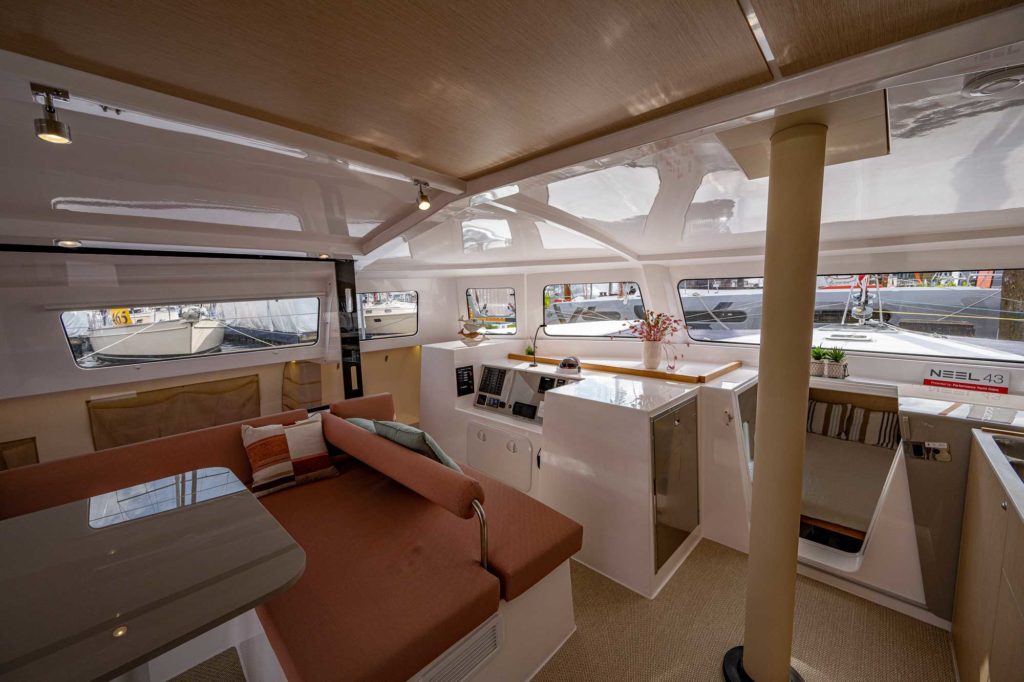
The boat’s overall interior concept is to have one large and connected living space, visible from hull to hull. Step through the main salon sliding door and the living quarters are all right there before you with a near panoramic view. There’s an owners cabin in one hull, a guest cabin in the other, and a sunken V-berth forward. The layout is a striking change from similar-size catamarans, where cabins are down and low in the hulls. On the Neel 43, there’s a feeling of inclusion, like a loft apartment. It’s not necessarily better or worse in terms of owner privacy, the judges say. It’s just different. What the trimaran’s large center hull provides is a giant mechanical room below. Open a hatch and climb down a short ladder to an airy and brightly illuminated space with all the boat systems accessible.
The boat is primarily intended for family cruising, Sastre says, but it’s ultimately for a sailor who appreciates performance. “When you trim in the sails, the boat lurches forward,” he says, thrusting his hips forward, “like whoosh! It takes off!
“With four on a long-distance race, it would be a blast [to] go around the island and then park the thing on a mooring and have a great night.” —Chuck Allen
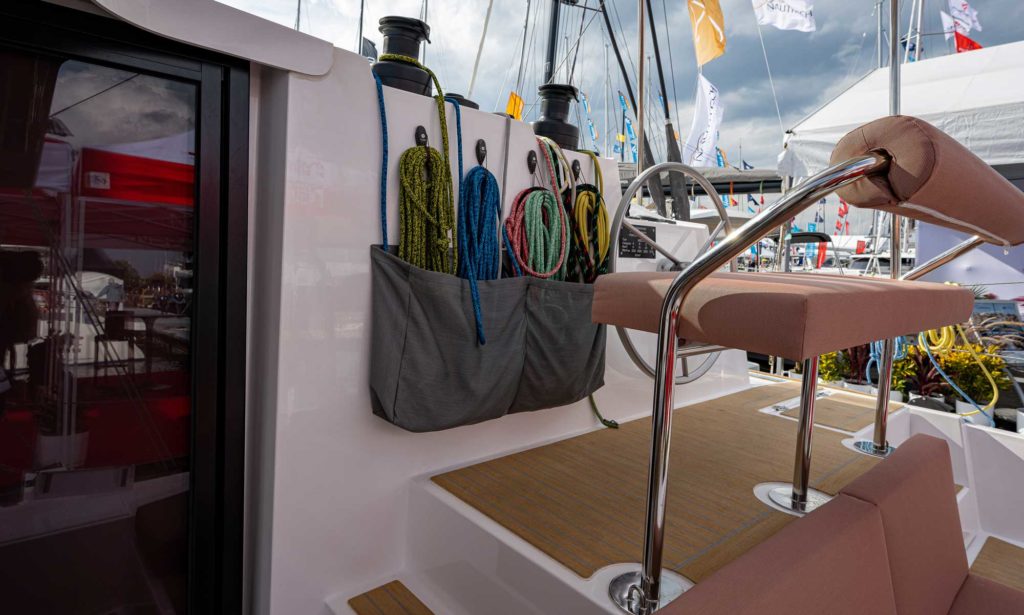
“A trimaran,” he adds, “is more stable than a catamaran and is faster than a catamaran, so sailing this boat is a lot of fun because helming it gives a feeling of great sensation. With the keel, mast and rudder on the center hull, trimming the amas is like a balancing act. It doesn’t heel too much, and it’s very stable. This is a platform for adventure.”
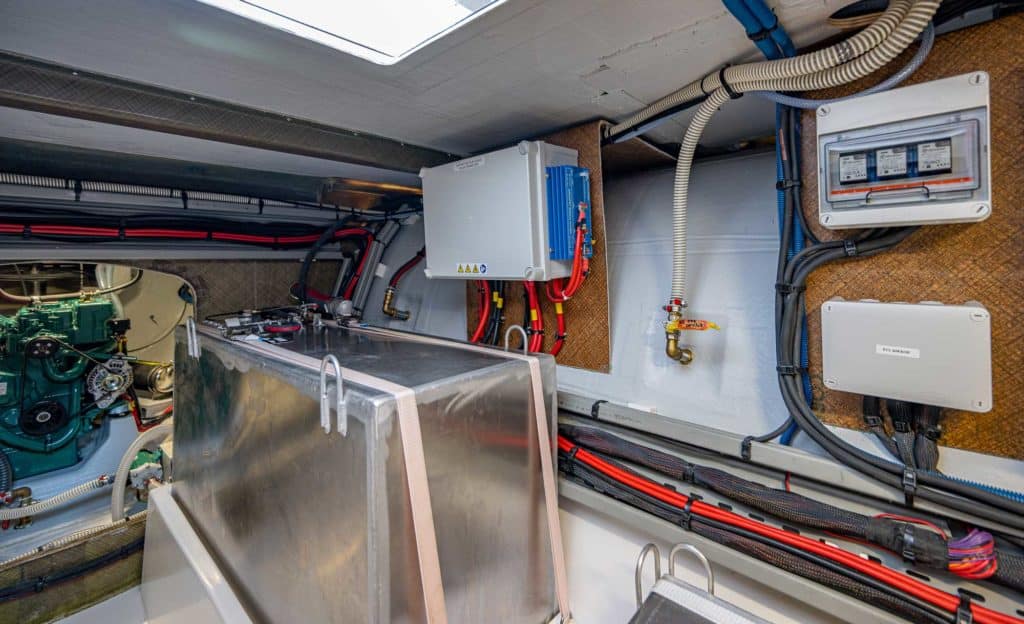
“It was the least multihull-like of all the multihulls we sailed,” Powlison says. “It handled like a monohull, and the third hull really makes a difference in being able turn the boat easily without stalling.”
The boat is an impressive build of vinylester and foam core, with nearly the entire hull built off with one mold. Neel touts use of eco-friendly and recyclable materials, and even cork is used as coring in some interior elements. Solar panels on the roof power the fridge and electronics.
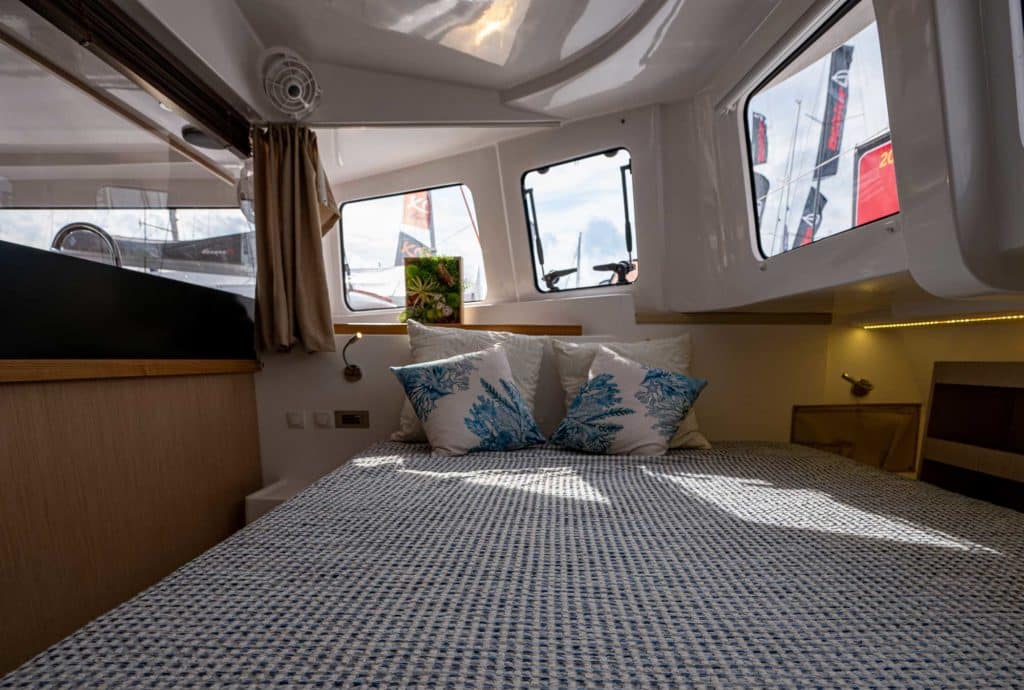
With a displacement of nearly 9 tons, there’s a lot of boat that spans 24 feet at maximum beam. Looking bow on, it’s a formidable-looking craft that glides quietly across the water when there’s all of 1,100 square feet of upwind sail area on the carbon rig. With its roller-furling gennaker deployed, the boat really lights up, as it should, Allen says.
The single helm is up high to starboard with good visibility, the judges note, with all the reef and control lines spilling into the helm area and into sheet bags.
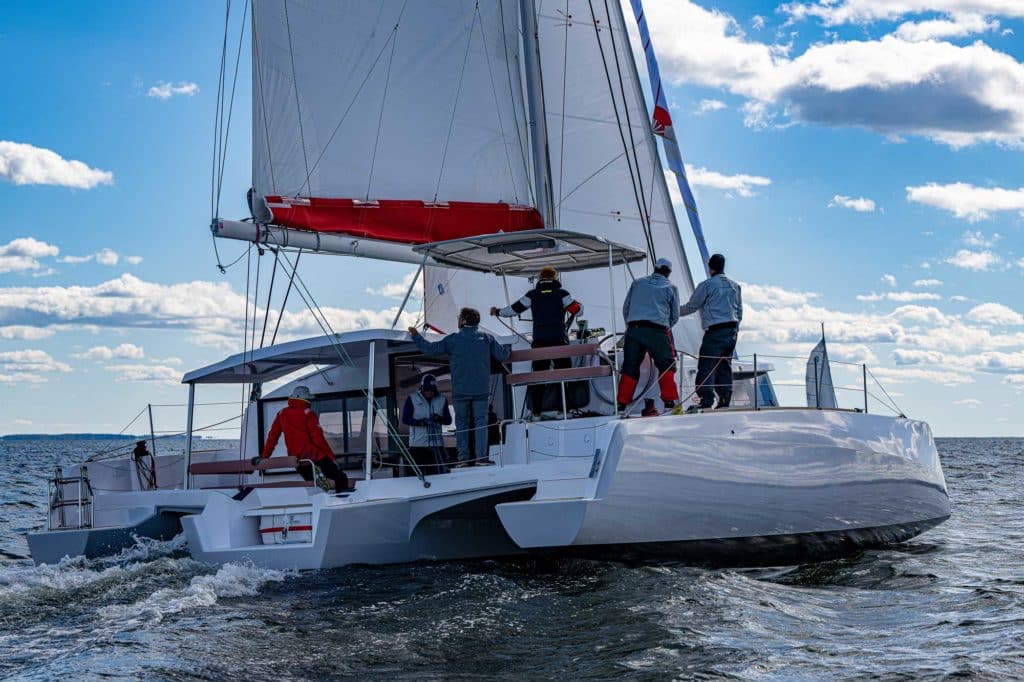
The Dyneema cable steering, Stewart says, was very responsive: “This is Hull No. 25, which is a good indication they’ve hit it right with the type of owner drawn to this type of boat. It definitely meets its purpose and does what it is supposed to. It’s stable and powerful, and accelerated well, even with the small jib. It felt far more nimble than other big multihulls we’ve sailed in the past. The way that it tacked easily is a really appealing trait for the type of racing an owner can do, like in the Caribbean, where the races are around islands and there can be a fair bit of tacking.”
First around the island means the first relaxing, and that’s what the Neel 43 is designed to do.
- More: 2023 Boat of the Year , Boat of the Year , Multihull , Print Winter 2023 , Sailboats
- More Sailboats
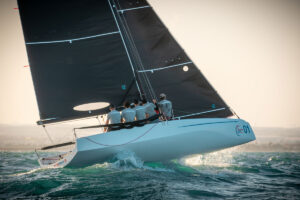
Sporty and Simple is the ClubSwan 28

Nautor Swan Has A New Pocket Rocket

Pogo Launches its Latest Coastal Rocket

A Deeper Dive Into the Storm 18
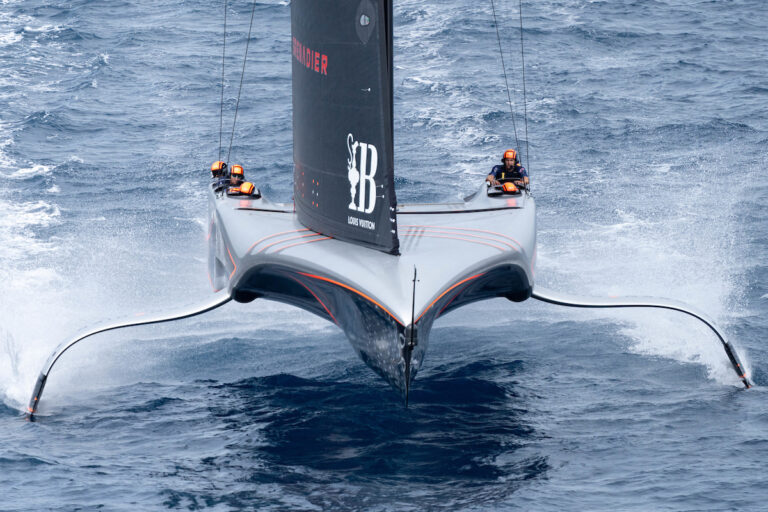
Barcelona Breeze Increase Spikes Intensity

Luna Rossa Dominant on Busy Day in Barcelona
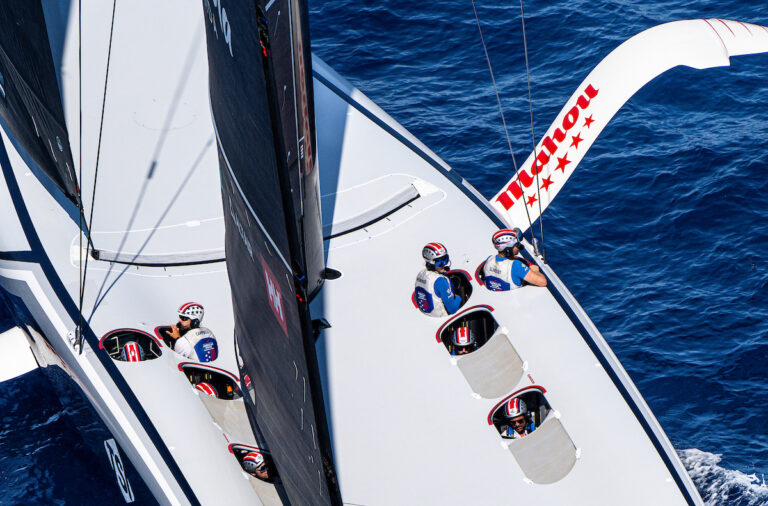
One and Done on Drifter Day of Cup Challenger Series
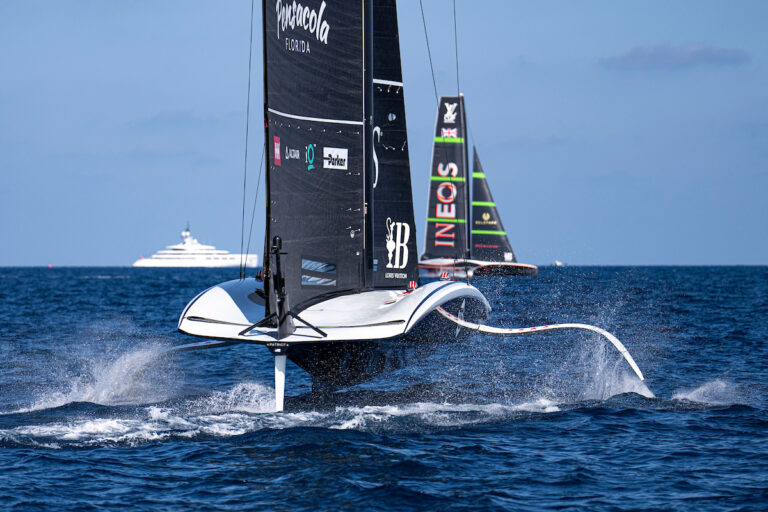
Shocks and Drops At Louis Vuitton Cup Start

- Digital Edition
- Customer Service
- Privacy Policy
- Terms of Use
- Cruising World
- Sailing World
- Salt Water Sportsman
- Sport Fishing
- Wakeboarding
Yachting Monthly
- Digital edition

Wow, that was fast! Why trimarans are SO much fun to sail – and how to do it
- Theo Stocker
- February 13, 2024
For their size, trimarans can punch well above their weight in speed, cruising potential and fun. Monohull sailor Theo Stocker gets to grips with how to handle one
Humans tend to gravitate into tribes of like-minded enthusiasts, enjoying the encouragement, support and sense of identity, while often looking askance at others; sailors at motorboaters, cruising sailors at racers, monohull sailors at raft, I mean, multihull sailors, and everyone looks askance at jet-skiers.
Large cruising catamarans (40ft now counts as a small one) are a world apart from monohull sailing, but there’s a sub-tribe of sailors dedicated to life on three hulls and builders such as Dragonfly, Corsair, Farrier, and Astus give them plenty of choice.
I’ve been sailing a 22ft (7m) Astus 22.5 this season, with just enough space for a family of four and a minimum of creature comforts. Thanks to her VPLP-designed hulls and 650kg all-up weight, we can sail upwind at 7-plus knots and downwind at over 10 knots with ease, all on a roughly even keel, while the kids play Duplo down below. It can also be beached and is towable behind a car.
Having, it seems, caught the trimaran bug, I wanted to get better at sailing and handling the boat, but my monohull sailing experience and habits were proving something of a hindrance, so we sought advice from some existing trimaran owners, and well as the UK’s top multihull sailors.
Much of the advice will apply to all multihulls , whether two or three-hulled, while other parts are just for small trimarans. I also found that brushing-up some of my rusty dinghy sailing skills helped get my head around what we were trying to do.
To try out our expert tips we went out sailing to see what difference they made. On the day, we got a solid Force 4-5 southwesterly, averaging 16 knots, but fluctuating between 12 and 20 knots true.
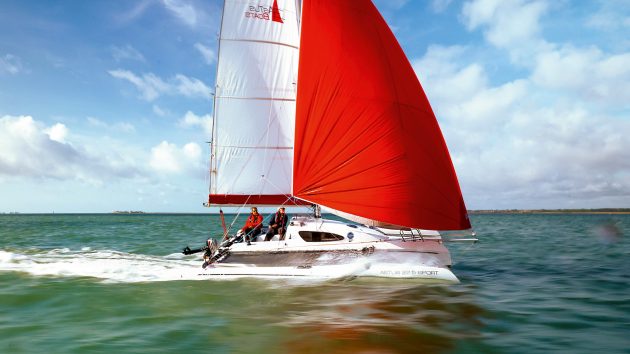
Blasting about on a sporty trimaran is a whole world of fun, but is much calmer than it looks
Trimaran sail trim
One of the biggest differences between a cruising monohull and a multihull is how the mainsail is trimmed. Leech tension on a yacht is often largely controlled by the kicker and the backstay, while the mainsheet sheets the mainsail in and out, predominantly controlling the angle of the boom to the centreline, and there may be a short traveller.
On a mulithull, however, there’s more than enough space for a good, wide traveller. Those who sail on performance monohulls will also be used to this. The sail shape is mainly controlled by the mainsheet, and the traveller then moves the boom towards or away from the centreline.
This is exaggerated on a multihull which has wide shrouds, swept well aft with no backstay, making space for a powerful square-top mainsail with full-length battens. There’s no backstay to bend the mast and flatten what is anyway a pretty rigid mainsail.
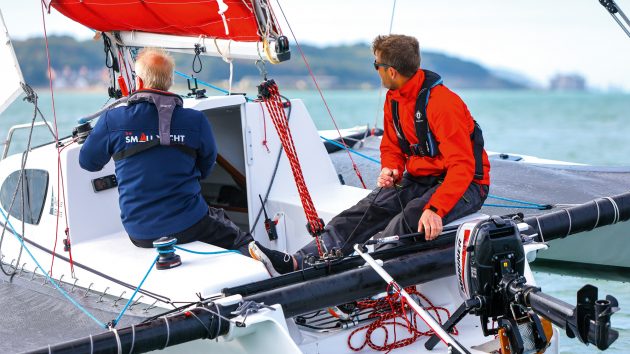
The mainsheet purchase creates enough power to control the leech of the square-top mainsail
Depowering a trimaran
Sailing on a monohull, heel and weatherhelm and eventually a broach give loads of warning that you’re pushing too hard. With straight hulls and little heel, those warning signs don’t really apply to multihulls.
In reality, however, there are a host of warning signals that it’s time to back-off; they’re just a bit different. Even then, there’s still a large safety margin before you get close to danger.
By way of reassurance, with the boat powered up on a beat, Hein, from Boats on Wheels, the boat’s owner, stood on the leeward hull and lent on the shrouds. Even as his feet got wet and the wind gusted at the top of Force 4, the boat didn’t bat an eyelid, thanks to the huge buoyancy of the floats.
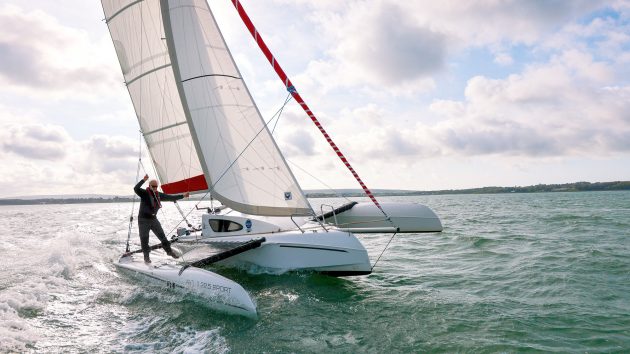
Even with a person on the leeward float the boat was extremely stable
On the water – sail trim
My first inclination was to point the boat as high upwind as possible, pin the sails in and go for height. Doing that resulted in a not-terrible boat speed of 5-6 knots and a good pointing angle.
Free off by a handful of degrees however, and ease the sails just a smidge, and the speed leapt up to 8-9 knots – over 50% more; a huge increase. So, don’t pinch. If you had a decent chartplotter on board, you could find your optimum speed to angle using velocity made good (VMG).
I was also tempted to pinch in the gusts, but it’s better to hold your course and let the speed increase until the main needs easing.
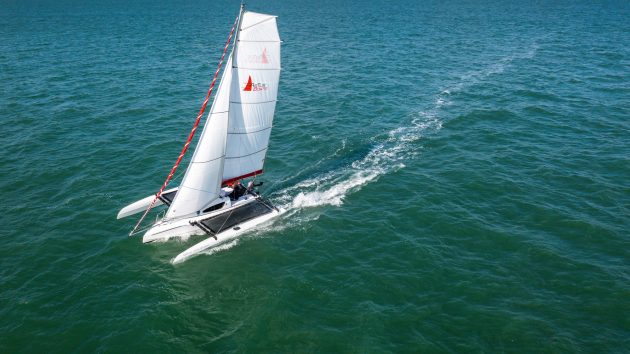
On the wind, it’s time to get the boat fully powered up
If that’s the case, drop the main down the traveller an inch or two or ease some twist into the mainsail and it makes all the difference in the world, but not so far that the top battens fall away and invert – that really isn’t fast. Push too hard and the boat will slow down, largely from the drag of submerging the leeward float and crossbeams. If you’re still overpowered and the main is luffing, it’s time to reef. Downwind is different, but we’ll get onto that later.
After we put a reef in the main, our boat speeds upwind remained largely the same, and the boat was much happier. I came away feeling reassured that even a little trimaran like this would be pretty difficult to capsize, and there were always plenty of warning signs telling me to take my foot off the pedal a little.
Article continues below…

Catamaran sailing skills: Mooring and anchoring a multihull
How do you make an average passage speed of 7 knots, fit in three double cabins and a huge saloon…

Monohull or multihull: which is best for blue water?
As former editor of Yachting World, David Glenn has plenty of experience of both monohull and multihull cruising. Here he…
Tacking and gybing a trimaran
Everyone knows that multihulls don’t tack as well as monohulls. Straight hulls and wide beam don’t lend themselves to turning, especially when coupled with the displacement and fixed keels of big cats. Trimarans are a little easier, with a single central daggerboard to act as a pivot, and one or other of the floats will generally be clear of the water. On the downside, light displacement means that there isn’t much momentum to keep you going through the turn and plenty of windage to stop you.
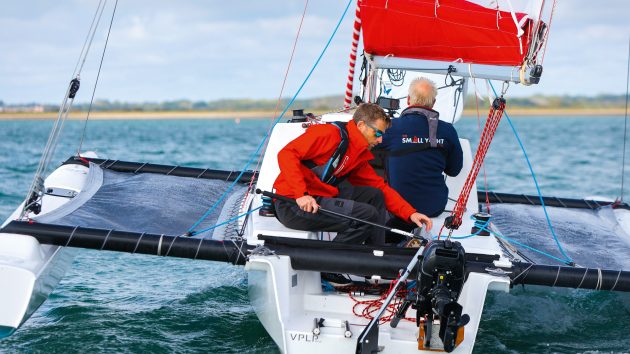
On a trimaran the central daggerboard helps the boat to turn by providing a central pivot point that catamarans lack
Speed is your friend. Build speed up before the tack to give you as much momentum as possible. The helm needs to steer positively into and through the turn, and if necessary, keep the jib backed on the new windward side to help the bow through the wind. Don’t worry about scrubbing speed off, but you don’t want to get stuck in irons.
When it comes to gybing, speed is again key. The turning bit isn’t going to be an issue as you’ll be scooting along, but the faster you’re going, the less load there will be on the sails. The more you slow down, the more the true wind will pile up.
Trimaran sailing skills
Tacks took a bit of practice. It felt plain wrong to jab the tiller across the boat, slamming a big break on in the water but I ended up putting us through the tacks far too slowly, losing a lot of speed. A more aggressive approach worked better. On the Astus, the traveller was between me and the tiller, so the tiller extension needed to be swung around the stern behind the mainsheet onto the new side.
Similarly, old habits of controlling a gybe needed to be modified. With the asymmetric set, we were planing at well over 10 knots, and the ideal is to stay on the plane. Heading dead downwind and centring the main lead to a more violent manoeuvre than flying into the gybe as fast as possible and, as the boom was never that far out thanks to the apparent wind angle, it didn’t need much extra controlling.
Coming up onto the wind after the gybe helped the asymmetric around the front of the jib and to fill on the new side. Stay too deep and it’ll get blanketed by the main. Once we had built up some apparent wind, we could bear away again.
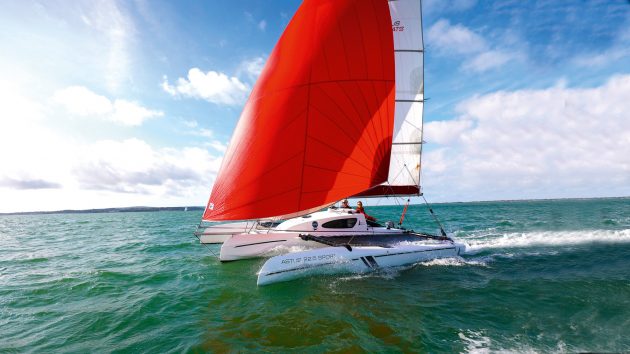
You’ll be on a course deep downwind before you know it, hitting speeds in the double digits
Downwind in a trimaran
Upwind cruising may be fun in a multihull, but bearing away and going with the wind is what it’s all about. Easily-driven hulls, a generous sailplan and light weight mean you can be up and planing, leaving displacement boats wallowing in your wake.
The big difference comes from apparent wind. If you’re in a boat that can do 15 knots downwind in 20 knots of true wind, the resulting wind angles can really mess with your head.
To get going then, says Brian Thompson, ‘Use those leech tell-tales again when sailing downwind and reaching to set the correct twist through the mainsheet, and use the traveller to set the correct angle of the whole sail to the wind.’
As the wind and your speed builds, bear away and trim the main accordingly.
In theory, you shouldn’t need to ease the traveller at all, but you may need to if you want to sail deep downwind. As the gust fades, you’ll find the boat slows down, so you can come back up towards the wind a little to pick up some more breeze, and then bear away as you accelerate again.

Bear away as the boat accelerates. Your course will be something of a slalom as you look to keep a consistent wind angle
This results in something of a ‘slalom’ course, and will also be accentuated if you’re sailing down waves, but that’s all quite normal for apparent wind sailing. Ultimately, you’re looking for a consistent apparent wind angle, even if the resulting wake isn’t straight.
It’s worth remembering that apparent wind reduces the felt effect of the wind, so you need a sailplan to suit the true, not apparent wind speed.
I found that the boat was more sensitive to having a balanced sailplan and trim downwind than upwind, largely because you’ve got almost double the canvas up, with the bowsprit as an extra lever. When weather helm built, I needed to ease the mainsheet to increase twist to depower so that I could bear away. I must admit, getting the boat balanced, sailing fast and light on the helm at 15 knots was something I came away feeling I needed more practice at.
Reviewing the images, I suspect the asymmetric was sheeted in too hard, with too much twist in the main.
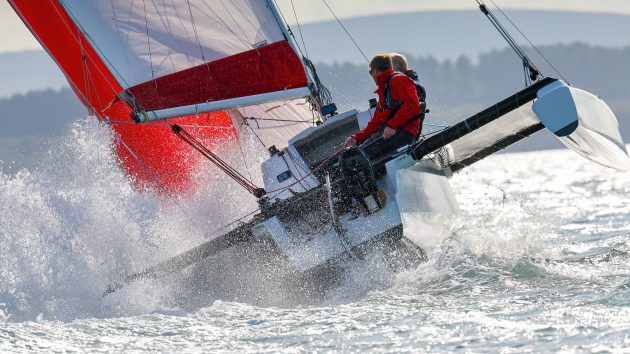
Getting a float fully submerged is when it’s time to back off
On the water
Unfurling the gennaker worked best on a beam reach, giving plenty of airflow over the sail to help it fully unfurl. This was also roughly the fastest point of sail, ideal for getting up some speed for apparent wind sailing. We mostly had the sails set for a close reach, even when we were beyond 120º off the true wind on a broad reach.
It was possible to soak deeper downwind, but lose the apparent wind benefit downwind and our speed dropped off dramatically, prompting us to point a bit higher to find some more speed.
As the boat powered up, it paid to hold a slightly higher angle than I would have done in a monohull for the boat to properly take off and get up into double digit speeds – topping out at 15 knots. Lymington to Cowes would have taken us just half an hour at that speed. It’s easy to give yourself a heck of a beat back!
We were sailing on a pretty flat day, so didn’t have to contend with any waves to speak of. On the recent RTI this is what caused the capsizes of at least two multis, a sobering reminder that you need to sail much more conservatively in lumpier conditions.
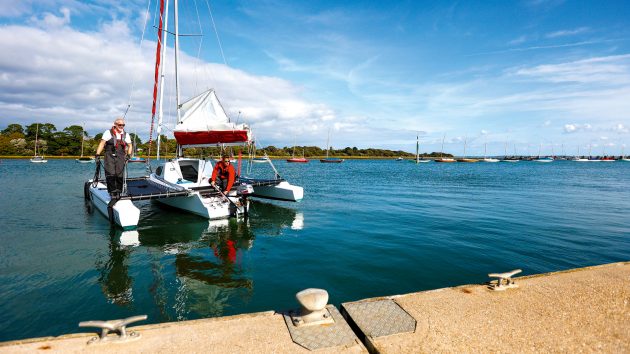
The bows want to point downwind, so a stern-first approach works with rather than against the boat
Coming alongside
A 650kg boat with no draught and plenty of windage feels dreadfully skittish when manoeuvring in confined spaces. Straight hulls with no forgiving curves and fragile-looking sharp bows make berthing tricky. You’ve got a couple of advantages on your side, however. In the Astus, the floats are at pontoon height making stepping off easy.
Whether you have an engine in each hull of a cat, or one in the central hull of a tri, there’s also a lot more leverage to play with to turn the boat and drive her on or off the pontoon. A steerable outboard gives you even more options.
If the boat has a lifting keel or daggerboards, put them down if there’s enough depth to give you a pivot and to resist drifting. Think about getting corners onto the pontoon, rather than putting the boat alongside. On tris, you won’t be able to get to the bow to fend off as it’s too narrow. You can rig a fender up forwards on a line, and two fenders are enough on the flat sides.
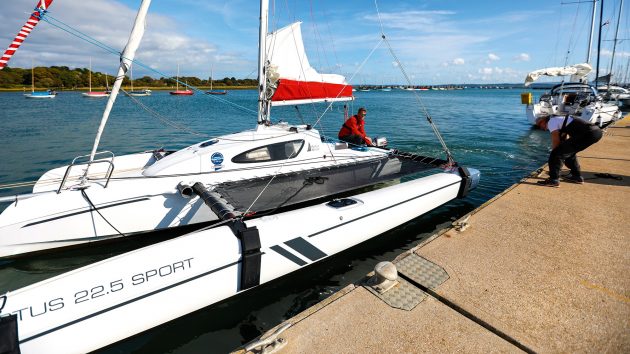
Steering with the outboard towards the pontoon will drive the stern in more; steer away to drive the bow in more
Offshore wind
Coming onto the pontoon with wind blowing off, it worked well coming in stern first. If there’s a tide running, you’ll want to be heading into the tide, so find a spot down wind and down tide to start your approach so you come in at an angle.
On our first attempt we had a bit of tide under us to start with so we came in at a much steeper angle, almost 90º, although this worked out OK in the end.
The crew could then step ashore, taking a line from the stern quarter round a cleat.
Drive forwards against the line and the bow will obediently drive up towards the pontoon, bringing you flat alongside. Getting off was simple, releasing the bowline, and allowing the bow to swing out the before slipping the stern line.
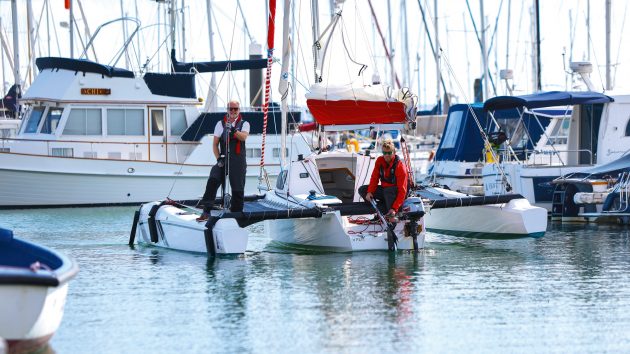
Coming in astern and stopping upwind of the berth meant the bows blew towards the pontoon far to quickly
Onshore wind
Getting onto and off a pontoon with onshore wind proved rather trickier. On our first attempt we came in stern first. The issue was that once we were just upwind of our desired berth and stopped, we lost steerage and the bow immediately blew off with alarming speed towards the pontoon.
Going ahead would only increase the force of the impact, while going astern only increased the bow’s sideways drift. I managed to back out without smashing the bow, but only just, and ended up awkwardly stern to the wind with the bows pointing at the pontoon.
On our second attempt we came in bows first but having aimed at the berth, I had to motor the stern to leeward to stop the bow hitting, making for a rather forceful coming alongside.
On take three, I came in forwards and began ferry gliding towards the berth early, keeping the bows to windward of the stern. Being able to steer with the outboard meant I could go ahead to keep the bow up, and go astern with the engine pulling the stern down toward the pontoon. In this way, it was possible to come in pretty well controlled and parallel to the berth.
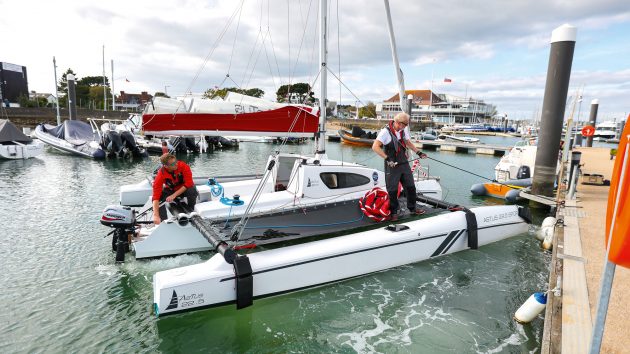
To get out, motoring astern against a bow line pulled the entire boat clear before slipping the line
Leaving was a different proposition all together, as I didn’t want to drag the bow along the pontoon, or to drive hard onto it to spring off. Instead, we rigged a slip-line from the forward cross beam. Going astern against this, and then turning the engine towards the wind, I could pull the stern, and the rest of the boat, out and away from the pontoon.
Keeping power on astern, once we’d reached a decent angle, we slipped the line and went astern, finding steerage way almost at once, with the bow following obediently in our wake with more control than I had anticipated.
Whether the wind is blowing onto, or off the pontoon, you want the engine to be driving or pulling the boat off the pontoon with a line on the corner you are going away from. That way you avoid point-loading fine ends where it’s hard to fender.
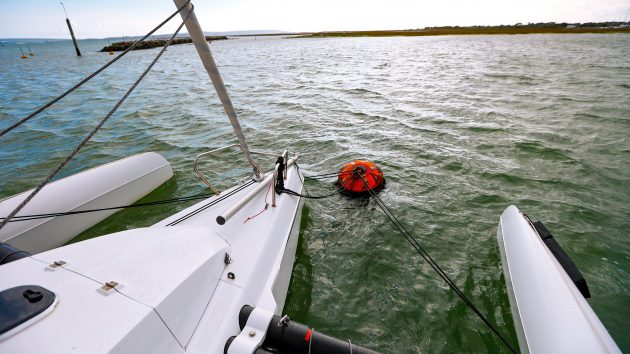
You’ll want a bridle to reduce swinging, but keep the pick up lines on the bow as backup
Anchoring and mooring a trimaran
While mooring a catamaran is complicated by the lack of a central bow, things should be simpler on a trimaran, and they are, mostly. Picking up a mooring buoy from the main hull bow with a low freeboard and dropping the pick-up line onto a cleat is easier even than a monohull.
The bow may be narrow, but for any lines that pass through a ring on the buoy, you still need to take it back to the same cleat to avoid chafe. That should be it, but windage from the two extra bows and the lack of keel mean the boat can dance merrily around the mooring buoy in a breeze.
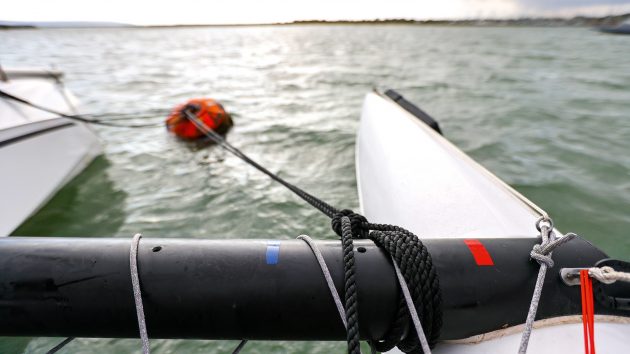
Rig the bridle so the buoy sits to one side to stabilise the boat
In practice, we found that a trimaran benefits from a mooring bridle in the same way that a catamaran does. It can’t be rigged from the floats’ bows, as there are no mooring cleats, so a line passed around the outboard ends of the forward beams gave a pretty good angle, again with long lines passed through the mooring and back to the same side. The main pick-up lines stay as a safety backup.
The other trick is to rig the bridle asymmetrically so that the buoy sits to one side or the other, just enough to not be dead head to wind, making it much more stable in the wind.
On the plus side, the lack of draught or keel means that you’ll nearly always be lying head to wind, so the cockpit remains nice and sheltered whatever the tide’s doing.
We ran out of time on the day to try anchoring, but rigging a bridle, effectively a long snubber to a point on the anchor chain in a similar way wouldn’t be tricky.
If you needed not to swing, or to behave more like deeper boats nearby, hanging a bucket over the stern can help, or there’s always anchoring with a kedge, either out ahead in a V, or in line astern.
Enjoyed reading this?
A subscription to Yachting Monthly magazine costs around 40% less than the cover price .
Print and digital editions are available through Magazines Direct – where you can also find the latest deals .
YM is packed with information to help you get the most from your time on the water.
- Take your seamanship to the next level with tips, advice and skills from our experts
- Impartial in-depth reviews of the latest yachts and equipment
- Cruising guides to help you reach those dream destinations
Follow us on Facebook , Twitter and Instagram.
Your source for the latest news on yachts, boats and more. Read through our articles to find out how to compare boats and find the right fit for you!
New Trimarans: which are the best ones
Jun 09, 2021
less than a min
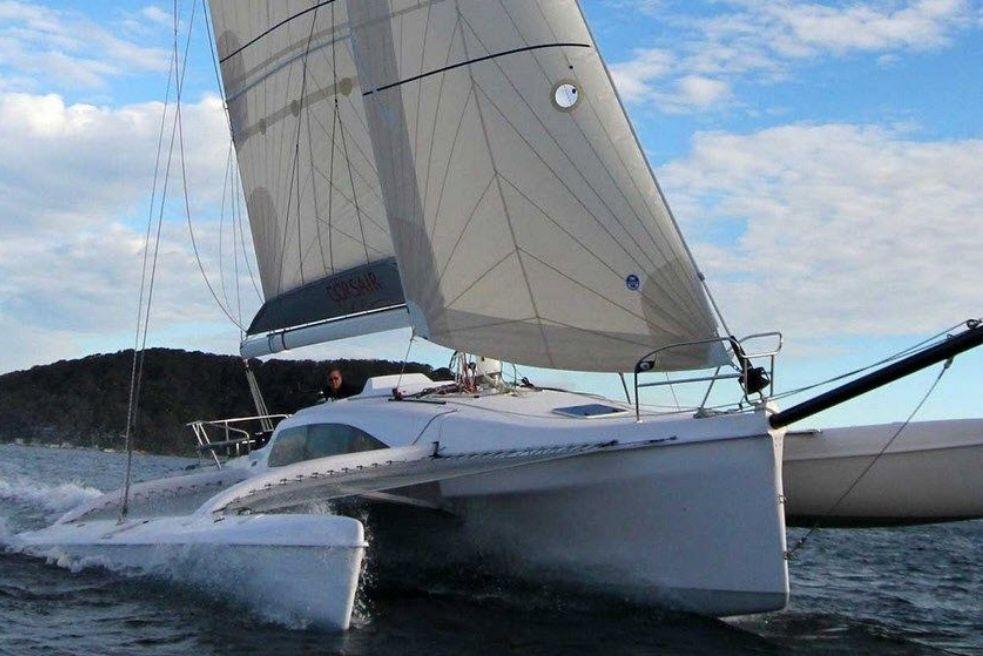
Trimarans are multi-hulls boats with three of them in parallel. They are considered unsinkable thanks to their geometry and shape, but also quite versatile and sporty. In addition, trimarans have a very futuristic look and an ingenious design which makes them one of the most unique vessels to sail in.
The new trimarans launched in 2021 have more interesting features and definitely more charm than anything you have seen before. Here are our favorites.

Neel 43 is one of the best new trimarans from the French Neel Trimarans company. It features a saloon, a galley, and two cabins for two people on top, and two single cabins on each bow. In addition, the cockpit and the saloon are connected through sliding doors which allows the spaces to flow within one another and yet maintain their own identity. This trimaran is 13 meters long and costs about €329,800.

Pulse 600 is one of the best racing new trimarans of 2021. It is seen as a big and yet quite an affordable vessel that is very fun to sail. Its multiple hulls are made of lightweight reinforced materials, very sleek and elegant. It features an open cockpit and can accommodate up to 4 people. Also, it can be sailed single-handed without any effort.

Rapido 60 is a new trimaran with a futuristic look. It reaches up to 18.1 meters with a beam of 11.7 meters and a draft of 0.75 meters. This boat has an average headroom of 2.1 meters and a mast height above water that reaches 25.3 meters. In addition, Rapido 60 has a 125 square meter mainsail and a 71 square meter Solent. Also, a 25 square meter storm sail is included, with a 130 square meter reacher and a 225 square meter asymmetric spin.

Dragonfly 28

The Dragonfly 28 offers a unique design that comes with not only one but two great new trimarans: the 28 Touring version and the Dragonfly 28 Performance Trimaran. The Performance Dragonfly 28, on the other hand, also comes in two versions, the Inshore and Offshore racer, perfect for people who love sports and adventure.
This is a very easy to sail trimaran, perfect for sailing solo or in company, as this boat can accommodate up to 5 people. Most importantly, this trimaran looks like a modern piece of art thanks to the elegant design and white shiny paint.

Corsair 37 is considered an unsinkable new trimaran that is not only secure but also super comfortable. It is made of built-in carbon hulls that can reach high speeds. The most unique thing about this trimaran is that it has been used in expeditions in the Arctic.
For more news and information on new trimarans, as well as other multihulls or monohulls, yachts, and sailboats, check out the rest of our articles in TheBoatDB blog. Also, visit the platform where you can browse multiple models and even benchmark and compare a few of them together. You can find out the lengths, displacements, interior, images, and more specifications of trimarans on our full boat database.
You might like these too

Sailboat or Motorboat – Learn the pros and cons lg ...
Aug 24, 2022

Types of Catamaran Boats: Sailing, Power, and Luxury Catamarans lg ...
Feb 10, 2023

Which is better a wooden boat or fiberglass boat lg ...

What are the main types of sail rigs for sailboats lg ...

Which is the Best Economical Catamaran lg ...
Oct 04, 2021

What is a Chine on a Boat lg ...
Oct 01, 2021
[email protected]

Tracer 1500TRi
Introducing the new 1500tri, the first member of the new tracer series of performance cruising trimarans from schionning designs. designed to blend the performance of a trimaran with liveable interior accommodation and create a stable, aesthetically-pleasing cruising platform that can take you anywhere in the world..

The 1500TRi exterior is a little different to many of the standard trimaran designs we've become accustomed to. Large spacious cockpit areas are located on either side of the cabin, with the helm stations positioned wide on the aft beam giving excellent visibility forward, as well as clear sight of sails and telltales. Lines run aft to the helms with winches and sail controls mounted close by for ease of operation. The large cockpit areas will be fantastic for swimming, sunbathing, storing dinghies & equipment plus just a great spot while underway.
A 19 metre mast can be rotating carbon or a standard alloy option, but with the performance aspect of this design carbon is recommended. she has fixed rudders on the floats, however this will not be an issue and she will still be able to beach easily. kick-up rudders are an option if desired and depending on your intended use for the boat. a single 30-40hp diesel is the recommended motor option., contact us for more info, exterior cad.

Interior cad

For more information please download our Study Plans on this design using the link below.
Tracer 1500tri - study plans & drawings.

About Rapido
The idea behind building the world’s best ocean-cruising trimarans came from the team that has built more than 1,500 production trimarans globally. The world-acclaimed Morrelli & Melvin was then tasked with developing the design and engineering for Rapido to start building! Separately, for those who think our advanced lightweight construction techniques have other applications, Rapido Catamarans adds an exciting new dimension to the fleet.

Latest News

August 22, 2024
Rapido Trimarans Statement regarding issues raised in Sailing La Va...
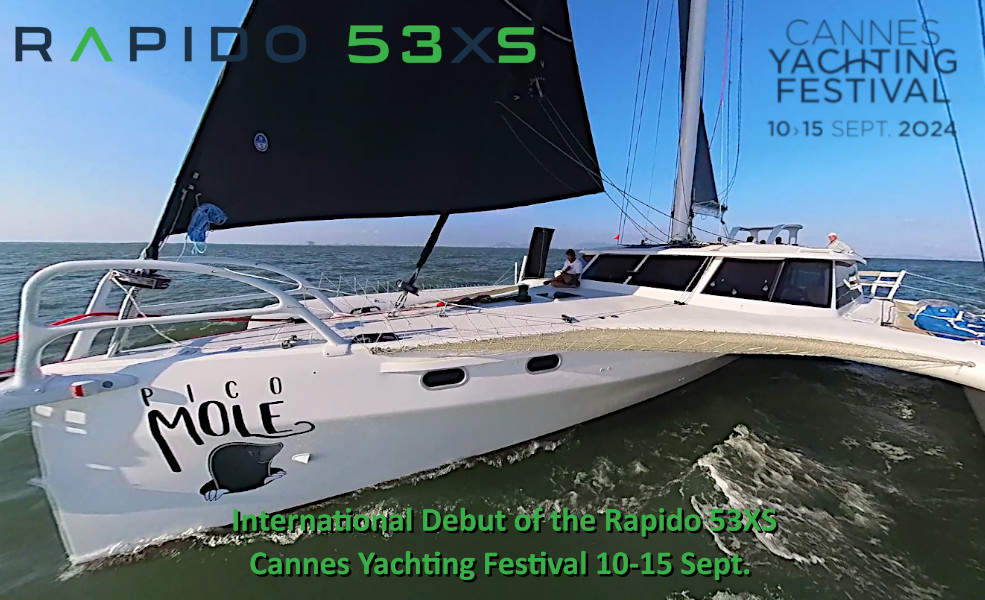
August 21, 2024
Cannes Yachting Festival 2024: International Debut of the Rapido 53XS!
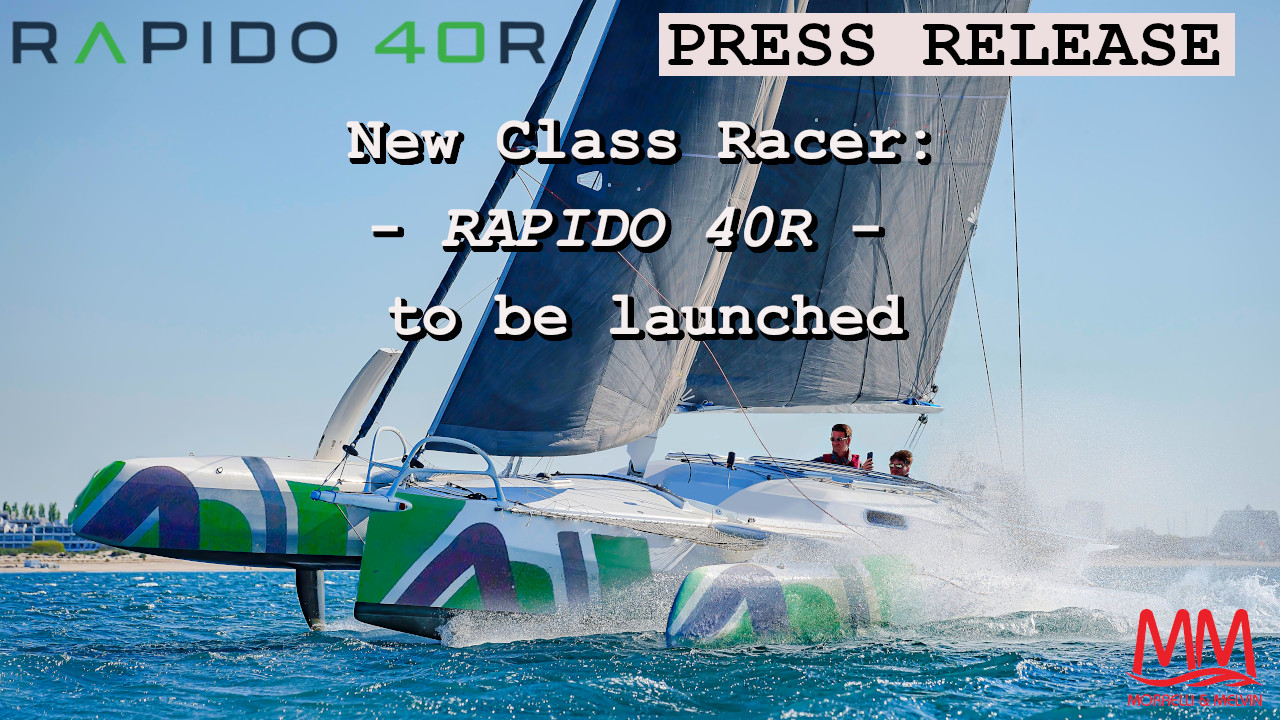
August 17, 2024
Press Release! New Class Racer, Rapido 40R to be launched. Special ...
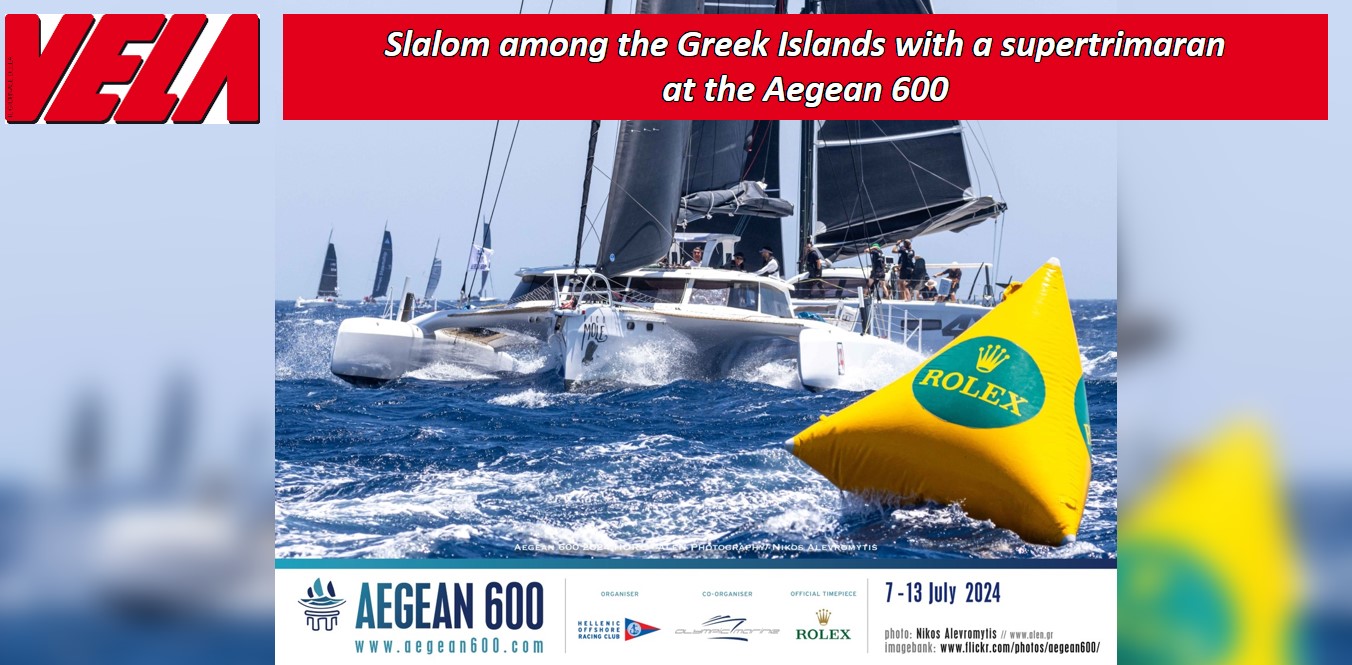
July 29, 2024
Slalom among the Greek islands with a supertrimaran at the Aegean 6...
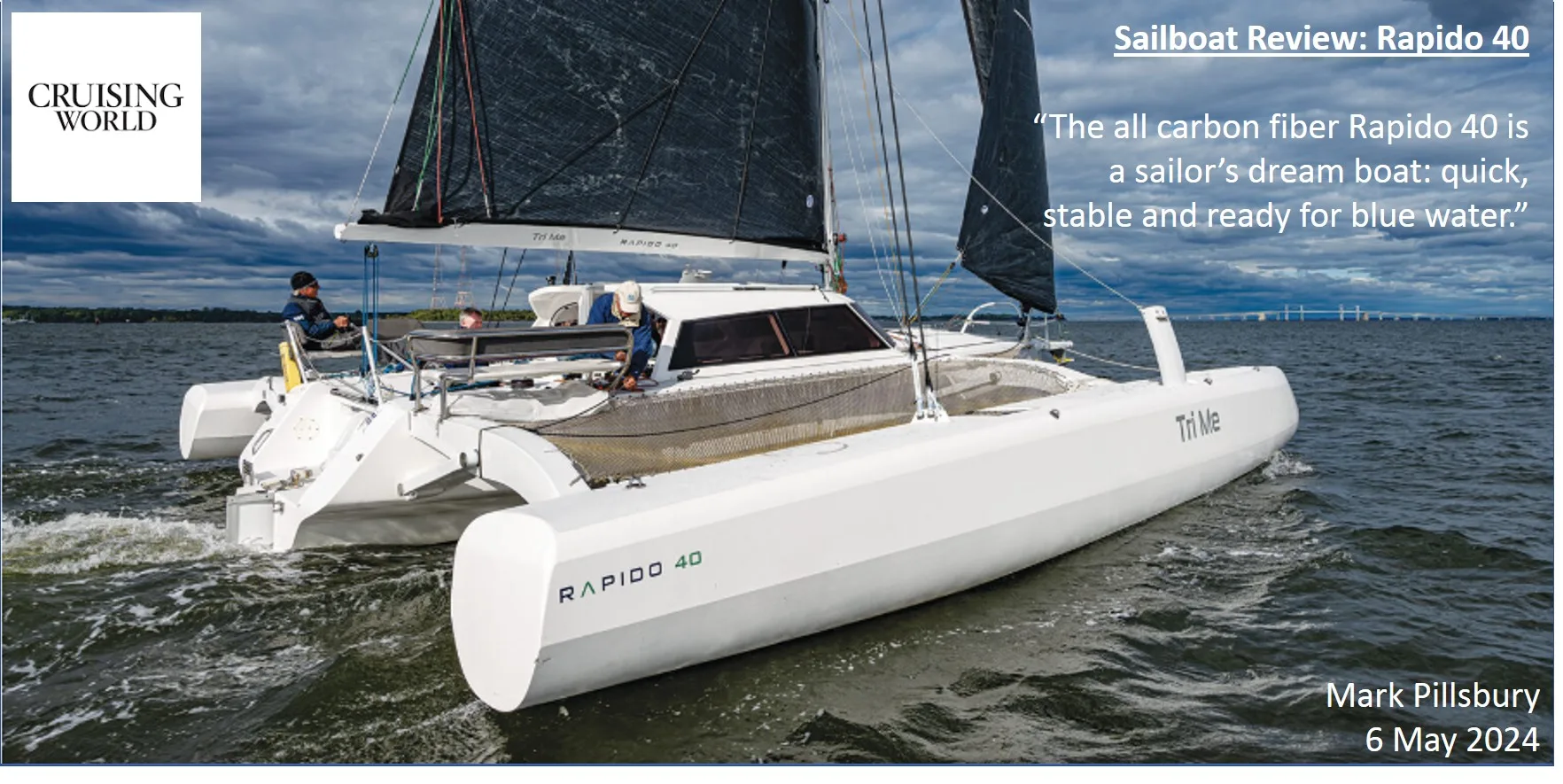
May 07, 2024
Cruising World reviews Rapido 40, a sailor’s dream boat
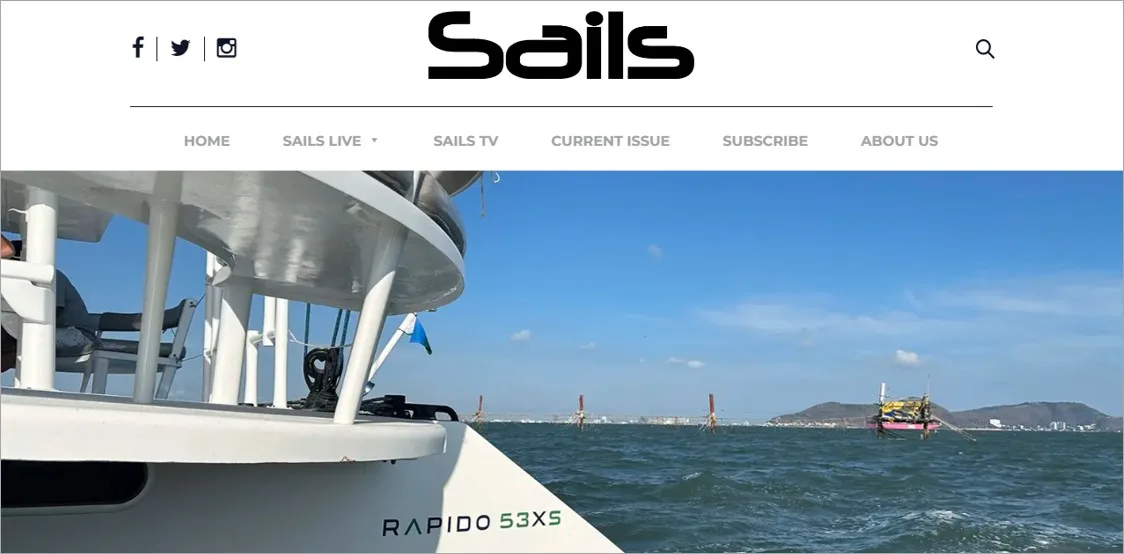
Rapido host much anticipated launch of first Rapido 53XS, Sails Mag...
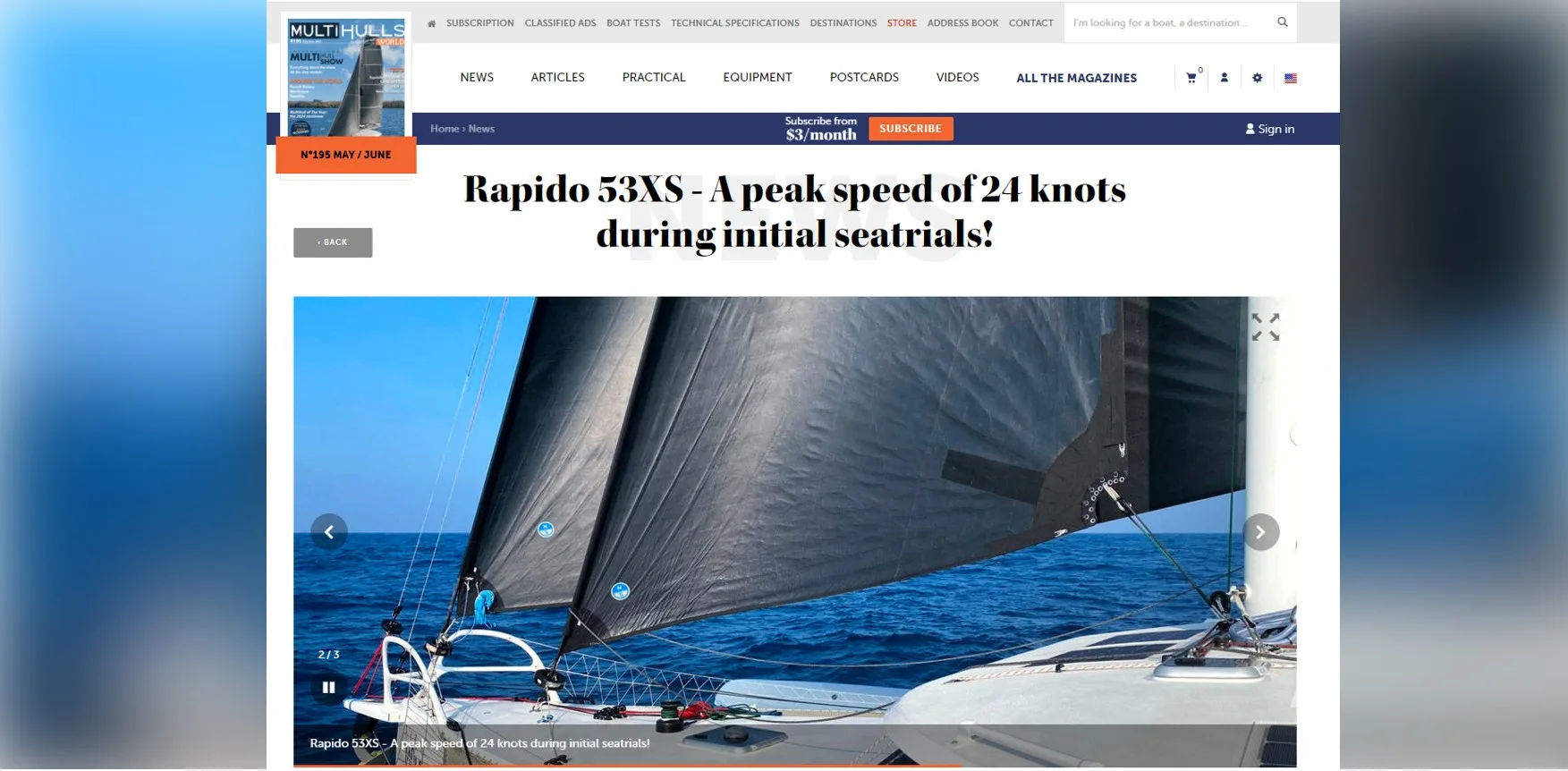
Rapido 53XS – A peak speed of 24 knots during initial sea trials!, ...

April 17, 2024
Video: Launch of Rapido 53XS #01 (Picomole) – event highlights
Discover rapido.
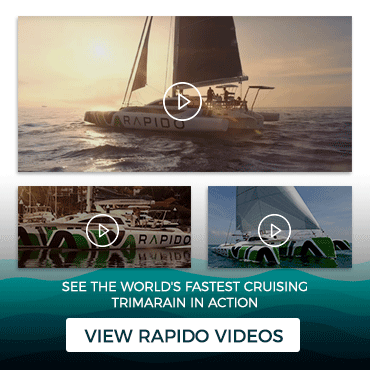
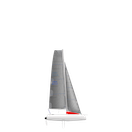
Folding System
Legendary ability, unbeatable reliability.
Folding and unfolding a Corsair trimaran takes only a minute. With just 4 bolts to remove, it is easily managed by one person, and is normally done while afloat. Simply raise (to fold) or press down (to unfold) the inboard end of one cross beam. It can be done from the safety of the cockpit and only a little force is needed due to the folding system’s carefully balanced geometry, and the movement of the floats being mostly horizontal.
The solid aluminium folding struts have absolute control over the folding motion and prevent flexing or racking. A stainless steel bolt on the inboard end of each beam secures the floats for sailing. Crucially, wingnets remain attached during the folding process – their frictionless fixing allows them to tension themselves appropriately through the folding process. The system is so simple and balanced that Corsair trimarans can even be folded while motoring.
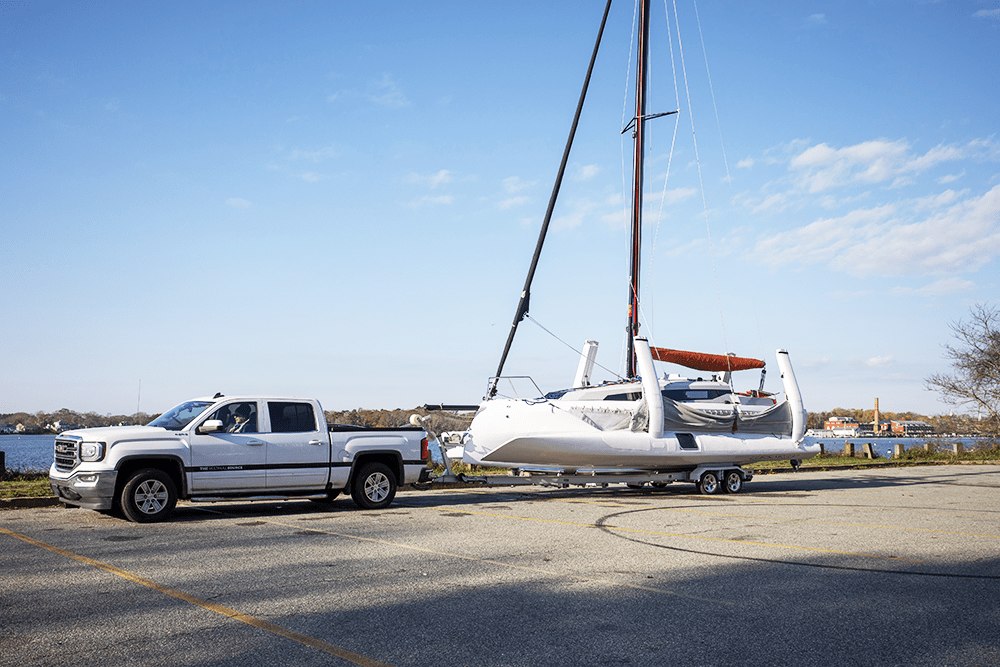
TRAILERING ACROSS CONTINENTS
Corsair Marine trimarans are especially weight-conscious, and sit low on their trailers meaning they have excellent trailering characteristics. They are equally easy to launch, giving you more time on the water, and the ability to expore many more remote cruising grounds or participate in regattas far from home. Some Corsair trimaran models go from trailer to water in 25 minutes, and with practice even the largest boat models can be done in 40 minutes.

Corsair 880 Trimaran | 2022 Boat Review by Multihulls World
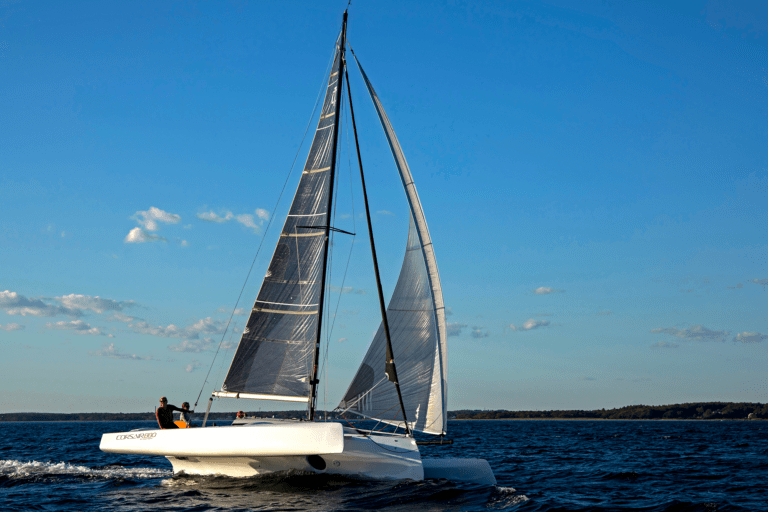
Corsair 880 – Drive Out, Fold Out, Thrill Out, Chill Out
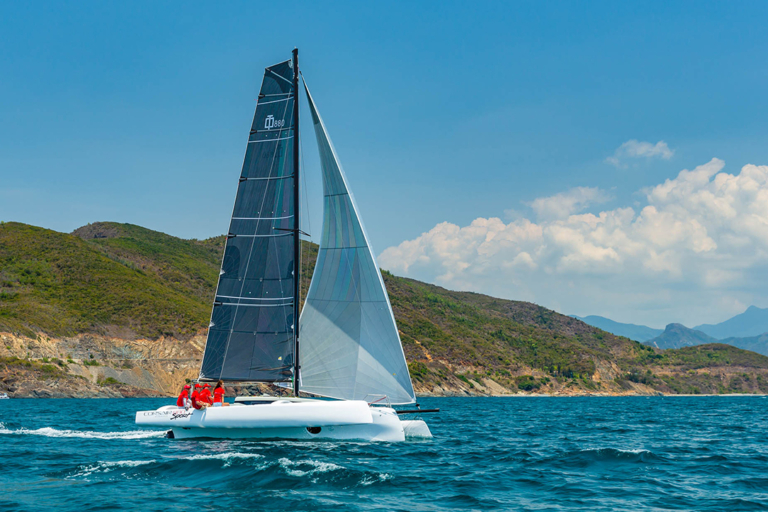
Australian Debut of the Corsair 880 at the Sydney International Boat Show
- Folding Corsair Trimarans: Legendary Ability, Unbeatable Reliability
- 5 Reasons Why The Corsair 760 Trimaran Won Multihull Of The Year
- Corsair Range Brochure
- Corsair Community
- Find A Dealer

Tel +84 28 3873 3630
Sales Enquiry:
Customer Service Enquiry:
© 2024 Corsair Marine International. Alls rights reserved.
Privacy Policy
Yachting World
- Digital Edition

Best catamaran and multihull: We sail the very best yachts on two and three hulls
- Toby Hodges
- March 20, 2024
Toby Hodges takes a look at all the nominees and the winner of the best catamaran and multihull category in the much-anticipated European Yacht of the Year Awards
There are many categories in the European Yacht of the Year awards, from the best luxury yachts and performance yachts to the best yachts for families and event a best specialist yacht category. But with multihulls rapidly increasing in popularity, the best catamaran and multihull category was possibly the most hotly anticipated.
The small number of entrants in this category in no way reflects the rich range or huge demand for multihulls. Many new models were launched by the big yards in the preceding years and they’re struggling to keep up with bulging order books.
However, these three shortlisted represented a choice pick of the latest fast cruisers and each, in their own very different ways, are responding to this insatiable demand for high end space and pace cruising.
Best catamaran and multihull
Best catamaran and multihull winner 2024 – outremer 52.
My highlight test of 2023? Sailing this Outremer 52 for 200 miles over two days and nights! Quite how such a large vessel, one that is capable of doing laps of the planet in true comfort, is also capable of providing such enjoyable sailing is the secret sauce that helps scoop this prize.
And it was pushed hard for this award by the disruptive HH. But the Outremer is such a well rounded, measured and thought out yacht for bluewater cruising at a reliable speed – it’s the full package, a dream boat for family bluewater sailing and arguably the French yard’s best and most refined model to date.
Designer VPLP was tasked with replacing the popular and well proven 51 with more comfort and stowage, while maintaining the performance. It says it took the best of the 55 (which won this award two years ago), and the best of the 51’s deck plan to create this 52. The result means too many good features to point out here, from the variety of helm positions, including a completely protected position inboard using the swing pedestal, to the well conceived spaces. I’d therefore recommend reading our full test report online or in YW’s June 2023 issue!
Neel continues to enjoy its cruising trimaran niche, using the wow factor of bridgedeck accommodation combined with the type of sailing enjoyment and feedback monohull sailors appreciate.
The impressive lightwind performance and direct feel of a Neel I am used to. But I don’t think I’ve ever been so surprised by the amount of cabins or space as I was on this 52. It’s available with four to six cabins plus the option for two crew cabins aft! Some of this maze works well, other areas, such as the forward cabins in the main hull not quite so well. Horizon and rig sightlines and some finishing also leaves room for improvement.
The HH44 seemingly manages to achieve the space and pace balance in a compact 45ft package, while also being one of the most innovative and exciting new production yachts I have sailed. From its looks to layout, to practical on deck solutions such as swing pedestals, side gates through the bulwarks and transom gates that double as swim platforms and boost cockpit security, it’s packed with fresh thinking.
And on the subject of ‘fresh’, the natural ventilation encouraged into the yacht through those massive forward facing coachroof windows which open – a feat made possible thanks to a stiff carbon composite structure – negates any aircon requirements.
With its deep carbon boards and tall carbon rig the HH44 is a powerful, reactive animal to sail. However, it’s the incorporation of the first parallel hybrid electric drive units which really makes this high tech high performance cat stand out. The electric motors are attached to the aft end of conventional diesel engines, not only providing silent power, but renewable energy through regenerative drives while sailing.
Best catamaran and multihull 2023
Best catamaran winner – nautitech 44.
If the very best catamaran delivers the ideal comfort to performance compromise, here’s a catamaran that seems to strike the perfect balance.
For those who cite a lack of visibility and protection as reasons not to choose this aft helm route, try sailing this first – direct steering brings so much more helming pleasure that you get the enjoyable feeling and communication more associated with a monohull. The attention to keeping weight low and central, vacuum infused vinylester build and a low coachroof and boom all aid this performance. The fine entry Lombard-designed hulls allowed us to properly point upwind at 8 knots (in 13), but it was the hands-on steering sensation that really stayed with me.
While there’s no real inside/outside boundary – the saloon bridges both – the Chedal-Anglay interior design works well. It is not as voluminous as some, but is certainly enough to be smugly comfortable at anchor, finished to a good quality, with walnut Alpi trim as standard. The layout option for a ‘smart room’ office/laundry/bunk room or stowage cabin is indeed really smart.
Out of all the multihulls nominated or sailed last year, this cat impressed me the most under sail. It’s the ideal size to go distance sailing, with good performance, low draught and space for family and friends. It had me dreaming.
Balance 482
I was drawn to the Balance 482, thanks to the combination of good looking modern design, high average speeds and, chiefly, the profusion of clever thinking and practical ideas that it brings. The South African build uses a foam core with E-glass laminate and cored furniture for a light weight of 11.3 tonnes, but also with the ability to take a generous payload.
An electric furler option combined with screecher sail helps offer effortless handling and fun sailing, although the 482 prefers a breeze in the double figures. Smart options such as load cells on the rigging, a bowsprit camera to monitor the anchor chain, plus engine room and mast cams all help for maintaining vigilance. Other features we like include the solar panels properly installed on raised brackets, raincatchers built into the coachroof, and how all sheets and lines are led to the helm station. But the prize solution is the VersaHelm, which allows you to swing the wheel inboard, close off the helm station, and stand watch and steer from a fully protected position.
Catana Ocean Class
The Catana Ocean Class is a bulky model which is geared more towards creature comforts than the higher performance of its predecessors. That said, it uses carbon in the structure and roof, foam cored furniture, the tanks are mounted low in the hulls and it has daggerboards and fine entry bows. The weight savings help it offer a massive 5.5 tonne cruising payload, plus there’s capacious stowage and large tank, refrigeration and laundry capacity.
Positioned between Lagoon and Outremer, the Catana echoes a bit of its sister brand Bali’s concept with its internal cockpit-cum-saloon layout while providing good ventilation via large sliding doors and opening windows. We liked how it’s easy to handle solo from one helm station, including the electric remote control of the boards, plus the layout of the galley and navstation.
Those chasing speed and helming pleasure should perhaps look to the C-Cat 48, as it’s as close to helming a fast monohull as a cruising cat is likely to get and one of the rare times we enjoyed sailing upwind in light breezes on a multihull! This is largely thanks to a lightweight, stiff build – the Comar yard has managed to save 1.7 tonnes over the first boat (9.5 tonnes light) and increased the draught of the curved daggerboards to 2.95m.
A carbon roof and rig comes as standard, as well as an epoxy hull, full carbon deck, bulkheads and compression beam. It is a little quirky with comparatively small volumes, but this François Perus design will outperform most other performance cats and monohulls of a similar length.
The Excess 14 shares that direct sensation you get from aft helms and some of the performance of the C-Cat, but in a more balanced, voluminous layout for cruising. The Excess 14 benefits from the research of VPLP’s Vannes racing office, where attention was focused on weight reduction, with savings particularly in furniture, on improved stiffness (PET foam cored sandwich for main structural bulkheads), and the efficiency of deeper fixed keels.
The result is telling on the water, as it should be for any best catamaran contender, where you can log easy miles: we clocked late 7s upwind, reached in the late 8s and regularly averaged 9 knots with gennaker in 12-15 knots. Clear glass windows give acceptable visibility from the helms through the coachroof and the comparatively minimalist interior. In short it offers a good mix of volume, reasonable performance and enjoyable sailing – see our full review last month.
Sailing performance was another key facet in the battle of the big cats from the big cat yards, Lagoon and Fountaine Pajot. Both models offer luxurious amounts of space for home from home comfort, as watersports bases for long term cruising.
The decision to push the mast to the front of the coachroof to allow for a larger genoa than its recent preference for self-tacking jibs has paid off on the Lagoon 51. It helped us sail efficiently into the waves (albeit not pointing too high) before clocking double figures reaching with the code sail in 15 knots.
The Lagoon’s large flybridge with dual access is a USP at this size that will be a hit or miss deal breaker for many. The 51 offers unrivalled accommodation volume in three, four or six cabins, and relaxation zones, and good circulation through these big spaces. Once again the jury applauds Lagoon for thoroughly testing the prototype model during a six month tour. Over 100 have already sold.
We saw in our December issue how the experienced owners of the Fountaine Pajot test boat choose to live and work full time aboard their Aura 51. It’s a design that promotes space, enough to take friends, family and crucially for them, all the toys to enjoy at anchor. Its capability of averaging 8-10 knots also appeals, although the single side helm and hydraulic steering result in scant connection to the sailing in light winds (the same applies to the Lagoon).
The fact the yard already offers this in a hybrid version and has an electric and hydrogen model in the pipeline could sway some, but the decision between the FP and the Lagoon will likely come down to preference between a central flybridge or offset bulkhead helm together with interior design and layout.
If you enjoyed this….
Yachting World is the world’s leading magazine for bluewater cruisers and offshore sailors. Every month we have inspirational adventures and practical features to help you realise your sailing dreams. Build your knowledge with a subscription delivered to your door. See our latest offers and save at least 30% off the cover price.
- BOAT OF THE YEAR
- Newsletters
- Sailboat Reviews
- Boating Safety
- Sails and Rigging
- Maintenance
- Sailing Totem
- Sailor & Galley
- Living Aboard
- Destinations
- Gear & Electronics
- Charter Resources
- Ultimate Boating Giveaway

3 Small, Sporty Trimarans
- By Herb McCormick
- Updated: March 5, 2009
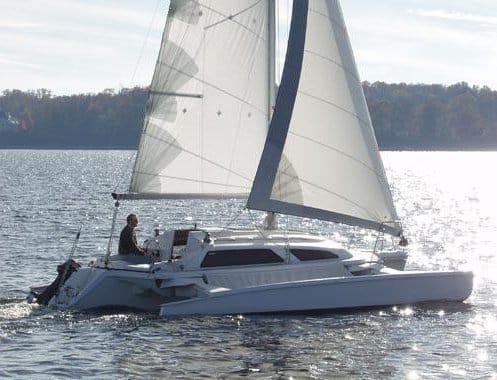
When it comes to cruising multihulls, the trimaran often plays second fiddle. The main reason is the sheer popularity and growth of cruising catamarans, thanks in no small part to the charter trade. But trimaran sailors have come up with a rather amusing handle for their beloved vessels: a cat-and-a-half. There’s some truth to the name.
If part of the reason one goes cruising is for a quality sailing experience, it’s hard to beat a well-executed tri. With shallow draft, they can easily poke into the shallows or up on a beach away from the madding crowd. And many midsize trimarans can be folded up and trailered for a cruise to Maine or the Florida Keys. As one tri sailor put it, “It’s sweet to go to windward at 65 miles per hour.”
I had the opportunity to sail a trio of cruising trimarans over a variety of waters and with an array of avid sailors and builders. Interestingly, the respective boats and venues-the Telstar 28 on Chesapeake Bay, the Corsair 31 on Massachusetts’ Buzzards Bay, and the Dragonfly 35 in the U.S. Virgin Islands-seemed especially well suited for one another. All boats are compromises, and trimarans are no different: Unlike cruising cats, which can handle those hefty payloads and multiple staterooms, tris are limited in space and accommodations by the parameters of their layout. But when all was said and done, I came away with a fresh appreciation for the viability of a relatively compact tri as a terrific, even exhilarating, coastal cruiser. Here’s what I discovered.
Telstar 28: Bred on Chesapeake Bay
The result of an exacting evolutionary process, the Telstar 28 is the proud creation of expatriate British multihull designer Tony Smith, who’s been testing and refining his notion of what makes an appealing triple-hulled pocket cruiser for almost four decades. His Chesapeake Bay-based business, Performance Cruising Inc., is very much a family affair, with his wife, kids, and son-in-law all prominently involved.
Smith launched the first incarnation of the Telstar, a 26-footer, in England in the early 1970s, eventually building 300 of them before relocating to this side of the Atlantic. A 1981 fire put the Telstar on hold while Smith shifted his emphasis to producing the Gemini line of cruising cats. But earlier this decade, he brought the trimaran out of mothballs and began to fine-tune his original vision, going through more than half a dozen prototypes before he was satisfied that he had a boat worthy of the marketplace.
For Smith, a hard-core multihull racer in his youth, the tug toward performance has always been strong. But with the Telstar 28, he wanted a boat that would be fun and fast under both sail and power but that could also serve for weeks at a time as a floating home, possessing features and systems that are foolproof and strongly engineered but dead simple to apply. A foldable, trailerable cruising boat sounds good, but it’s much less so if operating it is a chore for the owner.
And so Smith and his son, Neil, went to work, experimenting with rig size, outrigger shapes, and engine horsepower. They fussed with float deployment, steering systems, construction techniques, and numerous ways to raise and lower the mast. The goal was straightforward: a boat that sailed simply and well and that a couple or small family could enjoy. When he had everything just so, Smith made a couple of trips to Florida, by himself, trailering a Telstar. He launched and retrieved the boat, put the mast up and took it down, and went sailing, all alone. Only then was the reincarnated boat ready for prime time.
The revamped Telstar, now 28 feet long, has been in production for several years, and nearly 70 new boats have been built. On a visit last August to the boatyard on the Chesapeake’s Back Creek, Will Hershfeld, Smith’s son-in-law, gave me the tour.
Smith is especially proud of the arrangements for folding and deploying the outriggers and for stepping and striking the deck-stepped spar, both of which a lone sailor can do almost effortlessly in no time flat. The outriggers can be deployed or retracted on the trailer or in the water utilizing an ingenious rotary-pivot joint that reduces the maxed-out 18-foot beam to a mere 8 feet 6 inches in collapsed mode. The mast can be winched up (or lowered) from the cockpit via a set of four A-frames that work in tandem to support the stick during the evolution. Neither the sails nor the boom need to be removed for the mast’s raising or lowering, which maximizes the efficiency of the task.
Somewhat less heralded but also extremely clever is the tiller/outboard connection. With a single pin in place, the tiller and engine operate in tandem for optimum steering control under power. Under sail, the pin can be removed and the engine raised, thus linking the tiller directly to the rudder. The standard engine, incidentally, is a 20-horsepower Honda that scoots the boat along at a tidy 7 to 8 knots. A 50-horsepower Honda that will reportedly deliver 15 knots of boat speed is an option to form a sail/power version of the boat.
Belowdecks, the immediate and biggest surprise is the spaciousness of the central hull, particularly the 6-foot standing headroom. A large head compartment is forward of the saloon, which includes a pair of 6-foot-long settees flanking a folding dinette. With a series of slats in place down the main thoroughfare, one of the settees can be converted to a generous double berth. On either side of the companionway, a small galley with a two-burner stove and a simple navigation area addresses the essentials for dining and piloting.
Thanks to vacuum-bagged infusion for the outrigger assembly and a foam-core laminate in the main hull, the Telstar 28 weighs in at an almost unbelievable 3,000 pounds. The working sail area, augmented by the mainsail’s generous roach, measures 524 square feet. The power-to-weight ratio seemed promising, and I was eager to see how it translated to speed under sail.
The Chesapeake was in a cooperative mood as we powered out of Back Creek and set the main and 150-percent genoa in 12 to 15 knots of true wind. Sailing closehauled at about 30 degrees apparent, the boat slid along respectably at 6 to 7 knots with a well-balanced, fingertip touch to the tiller. We threw in a few tacks, and a couple of things were quickly apparent. First, the combination of formidable side decks along the main hull and fabric trampolines (not nets) between the outriggers made for an extremely dry ride, something I wasn’t expecting. But the 50-horsepower outboard on our test boat was a slight burden, dragging a bit, even when raised, on starboard tack. Our performance spiked when we flipped over to port and the propeller completely cleared the water.
The Telstar really came alive when we set the 400-square-foot screacher off the sprit. At 50 degrees apparent, we bettered 10 knots, and when we fell off to a beam reach, we topped off at a very lively 13.2 knots. A small chop was building on the bay, however, and it definitely slowed us down slightly, as the light boat just didn’t have the inertia to muscle through the wavelets. It’s a small quibble: I was already impressed. This child of the Chesapeake-an ideal cruising ground for this quick, shallow-draft trimaran-had displayed plenty of gumption on its home waters.
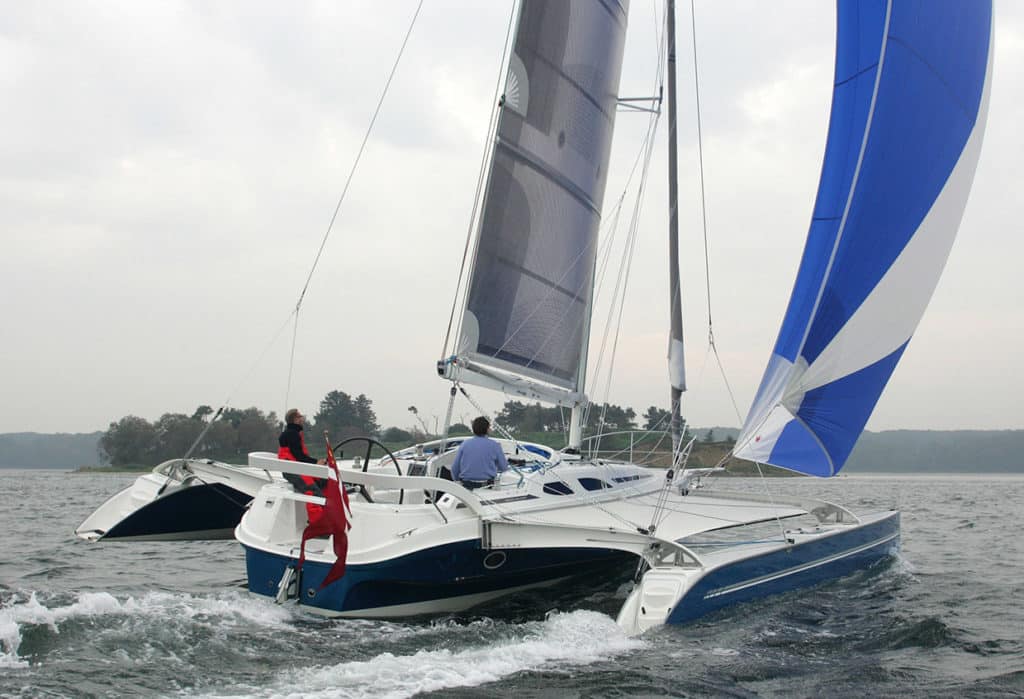
Dragonfly 35: A Trade-Wind Rocket
The marvelous Danish-built Dragonfly 35 stands apart from the other pair of trimarans in this roundup on multiple fronts, the most notable of which are size, cost, and accommodations.
In the protected harbor of Great Cruz Bay, in the U.S. Virgin Islands, I met Dr. James Clayton, the proud owner of hull number 11 in the Dragonfly 35 run. Looking for a bit faster ride, with roomier accommodations and better sun protection, Clayton had moved up to the 35-footer from the 33-foot Dragonfly 1000, a boat that he loved and which is no longer in production. The 35 comes in two versions, Touring and Ultimate, the latter, which Clayton owns, boasting a slightly taller carbon-fiber mast with exotic, high-tech Vectran/Technora sails and strong, lightweight standing and running rigging.
Clayton obviously enjoys a boat that performs well, but he also likes creature comforts, and he’s loaded the boat with a variety of options, including an Andersen 46ST electric winch for mainsail hoisting, a watermaker, a three-bladed folding prop (instead of the standard two-bladed version), a diesel heater, and even a bow thruster, which is employed via a “garage door” that lies flush to the hull when not in use.
It seemed odd to choose the high-tech version of the boat and then load it up (and weigh it down) with such a long list of amenities. But Clayton had good reasons for his choices. The bow thruster proves very handy in controlling the fine, light bow in close quarters on windy days, and the heater was welcome during a cruise through Nova Scotia.
The Dragonfly 35 employs the builder’s Swing Wing system to fold the amas, but with a 12-foot-10-inch beam when the outriggers are retracted (down from a graceful, sweeping 26 feet 11 inches in sailing mode), trailering isn’t an option. Still, the folded boat will fit into a standard marina slip.
The accommodation plan doesn’t enjoy the interior volume of a contemporary 35-foot monohull, but it’s a clean, modern design that makes excellent use of the space. There are generous double berths on either end: a V-berth in a dedicated cabin forward, and another double beneath the cockpit. An enclosed head is situated forward of the main cabin, which has 6-foot-4-inch headroom and features a long settee to port, a cozy but handy navigation station at the foot of the companionway, and a lengthwise galley to starboard, with an abundance of counter space and good storage. The Volvo diesel, with saildrive, is located in a dedicated aft compartment.
The deck layout and corresponding sailhandling systems are also extremely well executed. A retractable carbon sprit in a sealed, dedicated tube is just forward of the recessed Facnor headsail-furling gear. Four flexible 9.5-amp Sunware solar panels do a fine job of topping off the house batteries. The single-line reefing system is led aft to the cockpit, an extremely comfortable space with a large bimini overhead and a rounded helmsman’s backrest aft. The traveler is mounted on a central beam just forward of the helmsman, while the double-ended mainsheet is close at hand.
There’s good visibility for the wind and speed instruments mounted over the companionway, and clear sight lines exist to the Raymarine chart plotter mounted on the rear of the coachroof. A portable beam can be removed to provide walk-through access to the transom and the aft deck shower. Finally, each of the amas is equipped with a rear hatch, through which can be stashed a pair of 17-foot sea kayaks. The Dragonfly 35 can most definitely be classified as a sport utility vehicle.
We sailed the boat on a day of moderate easterlies blowing at 12 to 14 knots. Upwind, at roughly 30 degrees apparent, the boat made anywhere from 7.9 to 8.4 knots, and as we eased sheets and bore off, the speed ratcheted up accordingly, to 8.5 to 9 knots. Frankly, I was somewhat disappointed in the sheer speed (Clayton has made more than 18 knots in breeze ranging in the 20s), but as I mentioned, we were carrying a boatload of extras. It was a choppy day, but the Dragonfly was in no way hampered by the seaway. The V-sectioned central hull cleaved nicely through the waves without hobbyhorsing, providing a smooth, purposeful motion and leaving the smallest of wakes. And steering the boat was a real joy, with the Jefa rack-and-pinion steering system offering true fingertip control. I’d love to sail a 35 in big breeze.
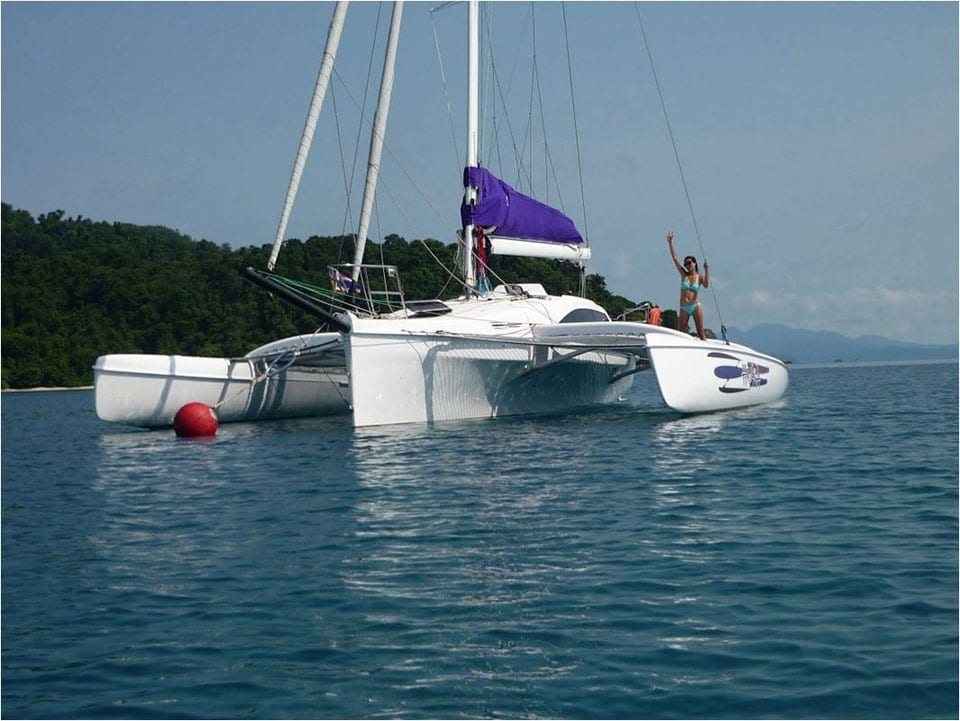
Corsair 31CC: Island Cruiser
The final stop on my Magical Trimaran Mystery Tour was Buzzards Bay, Massachusetts, the site of last summer’s annual Corsair Trimaran Nationals. That event was a fun, lively occasion with lots of action on the water and fun off it. No sailors, it seemed, were more excited about their boat than Charles and Hilary Badoian, who were spending the New England summer living aboard and cruising their Corsair 31, Ship o’ Fools.
The Corsair 31, originally designed by Ian Farrier and updated in recent times by Corsair Marine, has been in production now for well over a decade, with nearly 300 of them built. Originally produced in Australia, today they’re built in Vietnam. The 31 has been tweaked considerably from its inception, and it’s now available in four different models: the 31UC (Ultimate Cruiser), the 31AC (Aft Cockpit), the 31CC (Center Cockpit), and the 31-1D (One Design).
The One Design version comes with streamlined accommodations and a carbon-fiber rig with a retractable bowsprit as well as racing sails and modified foils, but it should be noted that every new Corsair 31-all of which now feature rotating masts-can be ordered with carbon rigs and retractable sprits.
The Badoians had been wandering through the Elizabeth Islands, southeastern Massachusetts, and Cape Cod for several months, and while they enjoyed the liveaboard lifestyle, they were also conducting, from their compact underway home, their full-time business as event planners. They’d come to the rendezvous to meet like-minded sailors, compare notes, and enjoy watching the racing from the deck of their own 31CC. Former owners of a Catalina 30, they’d made the switch to multihulls and were certain of one thing: After the easy speed and shoal draft of their trimaran, they weren’t going back.
Their 31-footer was actually an older model, built in 1996, but there are many similarities that have carried on through time. The most important was the basic layout of the center-cockpit version, which still features a V-berth forward, an enclosed head in the central cabin-along with a settee, a small dinette, and a surprisingly workable galley-and a second separate cabin aft, which is ideal for guests or storage.
The deck layout is also conducive to efficient shorthanded sailing, with the traveler and mainsheet well aft, easily within reach of the helmsman yet behind the tiller, making tacking and jibing a hassle-free maneuver. (In the Aft Cockpit version, the traveler is forward of the tiller.) The Badoians also were enamored of the roller-furling boom, another item that’s been passed down the line. Reefing, they said, was a snap.
The couple said they regularly enjoyed boat speeds ranging from 9 to 12 knots on Ship o’ Fools, which isn’t equipped with a bowsprit or a screacher. Unfortunately, on the day I sailed with them, the wind hovered between 5 to 8 knots, with only an occasional puff of around 10 knots. Still, under main and genoa, when it blew 5 knots, we made 5 knots. And when it topped 10 or so, we eased along at an effortless 7.5. In the flat water, steering from well outboard to get a clear view of the telltales, the sensation was almost more akin to flying than to sailing.
Corsair dealer Bob Gleason, whose Massachusetts brokerage firm, The Multihull Source, was hosting the Corsair Nationals, said that newer models far exceed the performance potential of older boats, thanks to a slightly taller rig, the aforementioned standard rotating mast, and the addition of a screacher mounted on a pole that retracts into a tube mounted in the forward cabin.
Gleason said the rotating masts also aid in raising and lowering the spar, as the outboard shrouds aren’t connected to the main hull; a pair of temporary shrouds are used to facilitate the operation. The amas of the Corsair 31 are also easily retracted and deployed via the longstanding Farrier Folding System, which hinges on just four bolts. The boat can be set up or put away by an experienced sailor in about half an hour.
The Badoians at some point may upgrade to a larger trimaran, but for now, they couldn’t be happier with their Corsair 31.
One of my fondest sailing dreams is to someday hop aboard a fast, zippy multihull, skip across the Gulf Stream from Florida to the Bahamas, and spend a long winter poking into every nook and cranny I can find. Without reservation, I’d happily take the Telstar, Dragonfly, or Corsair on such an adventure. That said, my time aboard left me with several observations about each boat.
The Telstar 28 is an extremely well-reasoned boat, but it was also first conceived in the 1970s, and unless you find beauty in utility, the profile is a bit boxy and certainly not as sexy as the other boats in this roundup. But with a price tag well under $100K, especially considering its portability in these days when moorage is at a premium, it’s also a good bargain.
The Dragonfly 35 is the gold standard in this collection, and given its $370K cost, it certainly should be. It’s foldable, yes, but not trailerable, and for some sailors in well-populated locales, finding a place to permanently moor it may be an issue. However, it’s also a solid, superbly crafted vessel that with its systems and potential for extended sailing, will take one anywhere in high style.
The Corsair 31 tilts toward the high-performance end of the spectrum, and for some sailors, it may be a handful. But there are options galore in the four respective versions, and other sailors will relish the competitive opportunities with a vessel that also provides more than reasonable accommodations for coastal forays. It may be the most versatile boat of the three.
In short, when buying any boat, it’s ideal to have choices. And if you’re in the market for a small multihull-no matter what your budget or intended plans-with this segment of midsize trimarans, there’s an excellent selection.
Herb McCormick is a Cruising World editor at large.
LOA 27′ 6″ (8.38 m.) LWL 26′ 3″ (8.00 m.) Beam (amas out/in) 18′ 0″/8′ 6″ (5.49/2.59 m.) Draft (board up/down) 1′ 0″/4′ 3″ (0.30/1.30 m.) Sail Area (100%) 524 sq. ft. (48.7 sq. m.) Displacement 3,000 lb. (1,361 kg.) Water 30 gal. (113.5 l.) Fuel 12 gal. (45.4 l.) Engine Honda 20-hp. outboard (Honda 50-hp. optional) Designer Tony Smith Price $89,500 Performance Cruising (410) 626-2720 www.performancecruising.com
Dragonfly 35 Touring
LOA 35′ 0″ (10.68 m.) LWL 34′ 5″ (10.50 m.) Beam (amas out/in) 26′ 11″/12′ 10″ (8.20/3.90 m.) Draft (board up/down) 1′ 10″/6′ 3″ (0.55/1.90 m.) Sail Area 904 sq. ft. (84 sq. m.) Displacement 8,598 lb. (3,900 kg.) Water 37 gal. (140 l.) Fuel 21.1 gal. (80 l.) Engine Volvo 30-hp. diesel Designers Borge and Jens Quorning Price $370,600/$404,700 Dragonfly Sailboats USA (908) 232-7890 www.trimarans.com
LOA 30′ 10″ (9.40 m.) LWL 30′ 0″ (9.15 m) Beam (amas out/in) 22′ 5″/8′ 2″ (6.84/2.5 m.) Draft (board up/down) 1′ 4″/5′ 6″ (0.41/1.68 m.) Sail Area (100%) 647 sq. ft. (59.9 sq. m.) Displacement 3,850 lb. (1,747 kg.) Water 25 gal. (94 l.) Engine 9.9-hp. outboard Designer Ian Farrier/Corsair Marine Price $151,000
Corsair Marine (619) 585-3005 www.corsairmarine.com
- More: 2001 - 2010 , 21 - 30 ft , 31 - 40 ft , Boat Gallery , Coastal Cruising , corsair marine , day sailing , dragonfly , multihull , racer / cruiser , Sailboat Reviews , Sailboats
- More Sailboats

Pre-Owned: 1988 Hylas 47

Catalina Introduces the 6 Series

Sailboat Preview: Elan GT6 Explorer

For Sale: 1984 Camper & Nicholsons 58

Galápagos: A Paradise Worth the Paperwork

Around Alone

Grease the Wheels of Your Boat: A Guide to Proper Lubrication

A Bowsprit Reborn: A DIY Renovation Story
- Digital Edition
- Customer Service
- Privacy Policy
- Terms of Use
- Email Newsletters
- Cruising World
- Sailing World
- Salt Water Sportsman
- Sport Fishing
- Wakeboarding

IMAGES
VIDEO
COMMENTS
This trimaran retails for $595,000, making it a cheaper option than the Rapido 60. 5. Dragonfly 40. The Dragonfly 40 measures 40 feet (12 meters) in length. It features high-comfort standards, making it one of the best trimarans in the market for taking your family for a cruise.
Best known for its use in camp cruising excursions, the Sea Pearl offers a roomy main hull and particular ability to sail in very shallow waters, making beaching and launching a breeze. The lightweight Sea Pearl trimaran is easy to tow, and the larger-than-expected cabin opens this vessel up for overnight adventures with plenty of storage space.
Runner-up: Rapido Trimarans 40. The Rapido 40 is a high tech, all-carbon, performance cruiser with a self-tacking jib, carbon spreaderless mast and an option for a roller furling boom. Walter Cooper. The design brief for the Rapido 40 is straightforward: fast cruising and racing for a couple or crew; ocean-ready but able to sail and moor in ...
The Dragonfly 40 Ultimate is a work of art inside and out, and when the sails are up, this tri flies. By Dave Reed. December 20, 2023. The craftsmanship and performance of Dragonfly's flagship ...
Above: The Rapido 60 Trimaran has turned the idea of small, limited space onboard a performance trimaran on its head by providing 260 square feet of living space with a comfortable design featuring a master stateroom and a fully equipped galley. There's an aft deck lounge area and the space ahead of the mast has been dedicated to a sun deck.
Best bluewater multihulls for pedigree cruising Lagoon 380 The long-time best-seller from the world leader in catamarans, with more than 1,000 produced over almost 20 years from 1999.
ENGINE: 2.5-5hp. TRANSMISSION: OUTBOARD. DESIGNER: Jean-Hubert Pommois/VPLP. BUILDER: Astus Boats, France. WEBSITE: www.astusboats.com. For fast yet undemanding sailing, easy trailing and simple camper-cruising, the Astus 20.5 trimaran is likely to find wide appeal says David Harding.
The new Rapido 40 trimaran is designed by Morrelli & Melvin, whose portfolio includes multihull rockets ranging from America's Cup contenders to Steve Fossett's Playstation, so no surprise that performance is in its DNA.But it's also a cruising multihull that's light, strong, easy to sail, and designed to fit into a standard slip, with retractable amas.
The Power of Three. Neel 43 2023 Best Multihull. Stated purpose: Family cruising, casual pursuit racing. Crew: Two to four. Praise for: Easily handling, open interior layout, overall positive ...
Cruising World Judges named the Neel 47 trimaran the Best Full-Size Multihull for 2020. In the large multihull class, at least for 2020, the Neel 47 proved that three hulls are better than two. The Eagle Class 53 was easily the most unique boat in the long history of Boat of the Year. Jon Whittle. It's hard to imagine three vessels, in a ...
May 6, 2024. The Rapido 40 is a high tech, all-carbon performance cruiser with a self-tacking jib, carbon spreaderless mast and an option for a roller furling boom. Walter Cooper. In the great debate among sailors about what's better—a monohull or a catamaran—both sides make compelling arguments. Monohulls are more efficient at going ...
This is the kind of space a professional captain would be proud of. If only four cabins are spec'd, there's also significant garage space where to stow all the equipment and necessities of long-range cruising. Above: The engine room on the 2022 LEEN 56 Trimaran. Photo by Olivier Blanchet / LEEN-TRIMARANS via Aeroyacht Ltd. in Long Island.
Neel Trimarans. France. The brand Neel Trimarans produces trimaran sailboats and is also active in the superyacht market. There are 4 models currently in production ranging from 12 to 20 meters. We invite you to explore all current and older models from Neel Trimarans and contact us for sales and pricing information.
The best small cruising trimaran so far remains the F22. The F22 Trimaran is designed by Ian Farrier and built by Farrier Marine company. It features a swan design and can be purchased in two versions, racing or cruiser form. This is a small trimaran that includes many interesting features within a compact space. It has a slightly offset ...
Trimaran sail trim. One of the biggest differences between a cruising monohull and a multihull is how the mainsail is trimmed. Leech tension on a yacht is often largely controlled by the kicker and the backstay, while the mainsheet sheets the mainsail in and out, predominantly controlling the angle of the boom to the centreline, and there may be a short traveller.
Rapido 60. Rapido 60 is a new trimaran with a futuristic look. It reaches up to 18.1 meters with a beam of 11.7 meters and a draft of 0.75 meters. This boat has an average headroom of 2.1 meters and a mast height above water that reaches 25.3 meters. In addition, Rapido 60 has a 125 square meter mainsail and a 71 square meter Solent.
Trimaran. Introducing the new 1500TRi, the first member of the new Tracer Series of performance cruising trimarans from Schionning Designs. Designed to blend the performance of a trimaran with liveable interior accommodation and create a stable, aesthetically-pleasing cruising platform that can take you anywhere in the world. Specifications.
The best cruising catamarans offer good load-carrying ability and respectable performance. As with any sailboat, a modern catamaran's design is a result of compromises. Daggerboards or keels? ... The Best Multihull Under 45 Feet: So said the CW judging panel in the 2013 Boat of the Year competition, regarding the Nautitech 441. ...
The idea behind building the world's best ocean-cruising trimarans came from the team that has built more than 1,500 production trimarans globally. The world-acclaimed Morrelli & Melvin was then tasked with developing the design and engineering for Rapido to start building!
The best builder of high performance trimarans. Discover our range of trailerable and foldable trimarans suitable for regatta racing and family cruising. The worlds favorite tailerable trimaran builder, suited to day sailing, family cruising and racing. Exit. NEW TRIMARANS. CORSAIR 880;
The multihull genie is out of the bottle, and there's no evidence it will ever return. That reality was once again underlined in the 2023 Boat of the Year trials, where the Cruising Multihull class, with five legitimate contenders, was certainly among the strongest categories. Particularly notable this year was the dominance of French ...
Neel 52. Neel continues to enjoy its cruising trimaran niche, using the wow factor of bridgedeck accommodation combined with the type of sailing enjoyment and feedback monohull sailors appreciate.
3 Small, Sporty Trimarans. The experience provided by three hulls will be uniquely different aboard this trio of thoroughly modern trimarans, the Telstar 28, the Dragonfly 35, and the Corsair 31. A boat review from our November 2008 issue. When it comes to cruising multihulls, the trimaran often plays second fiddle.